#and great characters with growth for both the player and the town/world at large
Explore tagged Tumblr posts
Text
Adoration to Ashes, Dust to Just — Thoughts on: Alibi in Ashes (ASH)
Previous Metas: SCK/SCK2, STFD, MHM, TRT, FIN, SSH, DOG, CAR, DDI, SHA, CUR, CLK, TRN, DAN, CRE, ICE, CRY, VEN, HAU, RAN, WAC, TOT, SAW, CAP
Hello and welcome to a Nancy Drew meta series! 30 metas, 30 Nancy Drew Games that I’m comfortable with doing meta about. Hot takes, cold takes, and just Takes will abound, but one thing’s for sure: they’ll all be longer than I mean them to be.
Each meta will have different distinct sections: an Introduction, an exploration of the Title, an explanation of the Mystery, a run-through of the Suspects. Then, I’ll tackle some of my favorite and least favorite things about the game, and finish it off with ideas on how to improve it.
If any game requires an extra section or two, they’ll be listed in the paragraphs above, along with my list of previous metas.
These metas are not spoiler free, though I’ll list any games/media that they might spoil here: ASH; mention of a whole host of previous games with the Hardy Boys in them; mention of SCK; mention of STFD; mention of FIN; mention of DED; small spoilers for SPY; unflattering mention of the Nancy Drew: Girl Detective series; brief mention of erotic-shifter-romance book Bearllionaire.
The Intro:
Welcome to the Nancy Games, lads!
Before we begin, since we’re at the beginning of a new “section” of games, let’s go over exact what the “Nancy Games” entail. Unlike the other games, this section (which runs from ASH through SPY) of games is most concerned with Nancy’s personality, growth, and showing her through a different character foil each game.
These games not only give us a better picture of who Nancy is, but also how she fits (or doesn’t fit) into the world around her and with the people that she meets. Rather than solving the case, these games are made to make Nancy react to things; rather than ‘where is Nancy Drew’ or ‘what case is Nancy Drew tackling’, the preeminent question for ASH and the four games after it is simple: ‘Who Is Nancy Drew?’.
Though only possible because of the nature of the miscellaneous games (WAC, TOT) and the Faerietale Games (SAW, CAP), the Nancy Games have been sorely needed since the series graduated past the first few cases. For a lot of the series, the games weren’t really concerned with the main character of the series, preferring her to be a blank slate that players could superimpose themselves onto…which, as recent media (such as Twilight, and Twilight But With Bondage This Time), isn’t a good basis for a character outside of a dime-store bodice ripper.
But these games aren’t Bearllionaire, they’re detective stories, and detective stories need a strong main detective to carry the story — not to mention the stakes.
That’s where these games come in. Building obviously to the story in SPY, each game explores another facet of Nancy’s personality, and shows what she could become — or could have become, in a few instances — should she let the more negative sides of her personality take over, or if she trusts the wrong kind of people and makes the wrong friends.
How better to illustrate than by showing exactly the kinds of people that Nancy’s friends are? That’s what ASH is primarily concerned about — showing who Nancy is by showing the reactions of people who have known her all her life to a crisis. The only difference between Nancy and her Foil in this game is the fact that Nancy has good people — good friends — fighting for her. It’s how she gets herself out of jail, and how she manages to solve the crime.
And it’s a fun (if a bit clunky) game mechanic as well.
This is why this story can only happen in Nancy’s hometown. Not only is it delightful for fans to see (modern-day, as we saw the old version in CLK) River Heights for the first time and get to explore a bit around the town, but hometowns in media are quite significant when looking at who a character is.
Almost always, a hometown is used as sort of a microcosm for the character, giving us a bit of a cheat sheet into who they are as a person just by showing their environment. Think about it — how many times in cop shows (which are the most blatant offenders by far) are we told that a character is from a small town, and thus they’re intent on proving themselves, probably a ridiculously hard worker (to get out of “that place”), and a bit more innocent than their inner-city colleagues? Or that a character grew up overseas to justify their interest in international crime, establish them as a bit of a wildcard, and handwave them knowing about 16 languages? Or that they grew up “on the streets”, justifying a hidden juvenile record, skills in hand-to-hand combat, and a soft spot for Youths Just Like Them?
(But enough about Criminal Minds. I’d rather focus on something that actually has thought put into it.)
The same thing is happening here in ASH; from River Heights, we can extrapolate that Nancy is well-off, straight-forward, comfortable largely around adults (think about it — ignoring the usual phone characters, we only meet one person around Nancy’s age in RH, and she hates her), and has a drive to be Somewhere Other than her small town.
Another interesting point is that River Heights is chosen as the backdrop for something that has only happened twice in the series, and only once been done well: a personal revenge story against Nancy herself. Sure, RAN attempted it, but RAN’s story is — if you haven’t read that meta, spoilers — hot, flaming garbage, and the personal revenge plotline is bungled to the extreme, resulting in it not putting across that theme very effectively.
ASH is different; from the very beginning, it’s obvious that whoever is doing this is working off of a person grudge against Nancy specifically — and burned down the town hall in order to implicate her, so they’re not playing around. It’s the reason that the culprit search is so focused, which really benefits the games as well. The question isn’t really “who would want to get rid of Town Hall”, it’s “who hates Nancy enough to burn down a building to get her in trouble”. It makes questioning so much more interesting — and very full of mines, which is Great — when it’s the person, rather than the specific crime, that matters.
The last thing I’ll touch on in this introduction is a question that the fandom has posed both seriously and jokingly many times over the last….almost exactly 10 years (10 years!!! I need to lie down my land!!!) since the game first came out: where are the Hardy Boys? Surely, if there was ever a game where they made sense to appear, it would be this one; their friend is in prison and needs the help of practiced investigators — you’d think that even if Carson wouldn’t think of hiring them (which, as desperate as he was, he totally would have), that Nancy would have given them a call, if only to see if ATAC had anything on the suspects.
There are two reasons why the Hardy Boys don’t appear, from a storytelling perspective (ignoring the issue of how much money it would cost to include them or any other technical considerations), no matter how much I would have liked them here, or how much sense it would have been to at least name drop them, if not make them phone friends.
The first is to keep the game centered on River Heights. Everyone in the game — both suspects and allies — is from River Heights and is a part of the town’s makeup. Our suspects reporter, a politician-slash-ice-cream-store-owner, an ex-detective-turned-antiques-dealer, and a college student born and raised in RH. They represent different facets of the town — the media, the political, the business, and the rising generation — and so each represent a part of the town. Nancy’s allies all fall under the “rising generation” — the “Future of the Town”, if you will — or under the justice system category, with Carson. Even the Chief represents another facet — the law — that can both hurt and help Nancy in turn. By keeping all suspects and allies tied to the town, the mystery and the story can focus on exactly what’s going down in River Heights, without any distractions.
The second reason that the Hardy Boys don’t appear is a little less obvious and a little less cut-and-dried plain fact, but I find it compelling enough to mention here: Ned is present. Other than as a foil in CAP (and an oddity in CRE/VEN), the Hardy Boys don’t appear in the games where Ned is present — it tends to be an either/or thing as far as phone characters are concerned. The why of this is, admittedly, conjecture, but I do find it fascinating that the two (three, technically) don’t intersect — and when they do, it’s to compare them.
Also there are not enough fics of the time Nancy sent Ned to hang out with the Hardy Boys like their house was a vacation kennel and Joe broke Ned’s car. Just saying.
Ned represents River Heights, safety, security, constancy, and comfort — the same things that the other River Heights phone friends (Carson, George, Bess, Hannah) do, albeit to a slightly lesser extent. The Hardy Boys, on the other hand, represent excitement, danger, the unknown, new discoveries, and growth — as do, in different extents, the non-River Heights returning phone friends (Hotchkiss, Savannah, Prudence).
Nancy sits squarely in the middle of these two extremes; she’s from River Heights, but she’s not exactly of River Heights, if you get my meaning. As the games have progressed, they’ve shown Nancy moving further and further away from safe, small, friend-related cases to professional jobs with more than a few people actively trying to kill her. For me, that’s the reason we don’t see the Hardy Boys and Ned mostly in the same games; they represent different spheres of Nancy’s life.
And, had competent writer(s) stayed and the games not, well, imploded due to Penny being one of the worst business people I’ve ever encountered, it would have been interesting to see that push-and-pull dynamic being expressed in Nancy’s relationships. As it is…thank Heaven for AO3, am I right?
Now, let’s refocus on ASH in specific, and talk about its composite parts, shall we?
The Title:
Other than being catchy and evocative (and telling us exactly what crime was committed here — that of arson), Alibi in Ashes is also a notable title for its flexibility in meaning. Like CAP, there are so many different connotations for “fire”, and all of them apply neatly to this game.
First, we’re dealing with the literal fire that sends Town Hall up in smoke, and the inciting incident for our mystery (and Nancy’s jail time). Next, we have the word “fire” standing in for “emergency” — as in “where’s the fire” — and there seems to be a new emergency every five minutes in this game — the fire, Nancy’s arrest, Bess breaking the vase, Carson’s absence, etc.
After that, we venture even further down the abstract hole, and dive into the political — whistleblowing, which is often referred to as “setting a/the fire”. This is partially what Nancy does, and is also what Brenda likes to do, no matter the accuracy of the report. Finally, we stay with Brenda for the term “media wildfire” – which is exactly what Nancy’s arrest (due to Brenda’s machinations) causes.
The title in total — “Alibi in Ashes” — also works in a few different senses. Literally speaking, Nancy’s alibi — and the evidence to prove it — is in the ashes of Town Hall, waiting to be discovered. More metaphorically, due to the work of the culprit, Nancy’s alibi (aka her innocence) is in pieces, in ashes — it’s been destroyed. Finally, in a literary sense, Nancy’s situation can be shown in the “ashes” of a past life — in the “wildfire” that destroyed Alexei’s life and career as a detective.
Its acronym being “ASH” is also pretty awesome, not gonna lie.
It’s the multifaceted nature of the title that really gives it its staying power, catchiness aside. Many titles are just as good as ASH’s, but almost none work harder at having so many possible meanings that are all represented in the text of the game itself.
The Mystery:
Sufficiently chastened into spending more time at home (at least for a few days), Nancy comes home in order to spearhead her team (consisting of Ned, Bess, and George) to victory in the River Heights Clues Challenge. This friendly little competition that included No Cheating Whatsoever on the part of Other Teams heats up, however, when a clue leads Nancy to the historic Town Hall — only to have it erupt in flames minutes later. Coughing but still moving, Nancy escapes the inferno…only to be greeted by the suspicious press, declaring her guilty of setting a beloved building on fire.
Things only get worse when Chief McGinnis shows up the next day, taking Nancy into custody due to political pressure in the town. An arsonist is afoot in River Heights, and unless her friends can dig up some dirt on someone — or everyone — else, it looks like Nancy Drew won’t just be convicted by the press, but by the town that raised her…
As a mystery, ASH has some great personal stakes — for Nancy and for our suspects — and pretty layered motivations. The cast comes alive through their relations to Nancy, especially as she’s unprotected with Carson being in Australia. The shift in the mystery that occurs when Nancy can finally get out and speak to the suspects — and seeing how differently they treat her than how they treated the other members of the cast — really helps to add something new to a mystery that’s tying itself up a bit, and give it the last push of gas it needs to get us to the conclusion.
While it’s not the most involved, complex, or thematic Nancy Drew mystery ever, it does what it needs to do, and does it well – and that’s honestly all I want in a game more devoted (as it should be) to character than it is to a twisty plot.
The Suspects:
ASH has a rather full cast (not because of the size of the suspect pool, but because there are so many people involved that should be mentioned), so let’s get started with our suspects, then move on to our other cast members.
Brenda Carlton, resident Reporter of River Heights News and perpetual thorn in Nancy’s side, is both our first suspect and our culprit, proving once again that the media cannot be trusted. We haven’t had a reporter be our culprit in 21 games (TRT’s Lisa being the previous example), so I guess we were due, but Brenda is a delightfully hateful example of just how bad the media can be, so kudos for that.
And this game didn’t even come out in an election year. How refreshing.
As a suspect, Brenda is awesome. Catty, arrogant, and with a penchant for dressing up as Nancy – titian wig and all! – to perform her dastardly, dastardly acts, the game doesn’t try to be subtle for one second that she’s up to no good. While Nancy and Brenda are equally as interested — and equally as talented, by all appearances – in ferreting out a good story, Brenda takes it a step further and makes one if she can’t find one – and nurses a grudge against Nancy for exposing her for it.
Up next is ice cream shop owner and scaly politician Antonia “Toni” Scallari, a woman with a bright-eyed, smiling public face — and if you don’t like that face, don’t worry…she has others. Toni is your typical politician — pretends to be nice and pleasant, is actually a scheming villain, hates people who do honest work, and thinks that fairness in government is a luxury – but the game does stop shy of making her The Villain, preferring instead to show the crimes she’s committed in her search for money and power and letting her quietly bow out of the election.
So definitely better than she deserved, but at least the game shows her corrupt nature rather than sweeping it under the rug.
As a suspect, Toni would have made a decent villain, but it would have turned the game into a tale of cold political expediency and machinations, rather than hot-blooded revenge, and that would have been a shame. I’m a fan of how the games from about TOT on always have multiple characters who Do Crimes and Bad Things, and Toni is a prime example of a bad guy who just happens not to be The Bad Guy.
Third on the docket of suspects is our resident grumpy old man (and Nancy’s foil in this game) Alexei Markovic, who provides not only some of the best voice work in the game, but whose age is also proof that Nancy’s dad really is the silver-haired DILF we’ve been waiting for.
C’mon, he prosecuted Alexei when Alexei was 20. The youngest Carson could have been was 25 if he booked it through college, took no breaks to study for the LSAT, and blazed through law school — and immediately got a job the day after graduation. And seeing as Alexei has the “old coot” personality and grey hair…well, Carson is probably straddling the line between DILF and GILF.
(I’m so sorry for that aside, guys, it got away from me. I’m equally sorry for the first recorded use of the term “GILF” in the Nancy Drew fandom. It’s not the legacy I wanted, but perhaps the legacy I deserve.)
Back to Alexei!
Alexei is a great character, full-stop, and his VA just improves the experience more. Bitter and jaded, but by no means uncaring or evil or myopic about his troubles, Alexei is, where Nancy is concerned, a bleeding heart whose blood happens to run cold. While he could be bitter about Carson playing a part in taking away everything he had, and thus treat Nancy poorly, he instead empathizes deeply, wants to help, and, in effect, treats her the way that somebody — anybody — should have treated him.
As a suspect, Alexei, as Nancy’s foil in the game, would have been a poor choice; he’s not really there to be suspicious, he’s there to show the stakes of the mystery. No matter if Carson could find a world-class defender to get Nancy off the charges, no matter if they couldn’t even indict her, the stakes aren’t “Nancy will go to jail for Realsies” — the stakes are the town turning its back, she loses those she loves, and is unable to do the job that is the essence of who she is. In other words, if things go poorly, Nancy becomes Alexei.
One of the reasons that Alexei is such a good character is that he recognizes this immediately, and is determined to do all he can to prevent that. Sure, he knows the odds are stacked against him, and the whole town is his enemy, and he won’t get anything for helping out — but at his heart, he’s still the Magnificent Markovic; “no case too big, no fee too small,” remember?
Last of the actual suspects is noted red-light runner and girl in envious, envious green, Deirdre Shannon. Deirdre’s a rather divisive character in the fandom — especially of late — but is a character I stand firmly on the side of great, for a few reasons.
The first is that the games took a 1-dimensional, wouldn’t-cast-a-shadow-if-you-turned-her-sideways character from the Girl Detective books, there purely to make Nancy look good, and instead gave her a fully realized character, sympathetic motivations, and a whip-sharp tongue.
The second is her hilarious banter with the River Heights crew and wry sense of humor, which would be enough to make her a favorite character of mine alone.
Annoyed by constant, unflattering comparisons to Nancy from her parents (her father also being a lawyer in River Heights), she’s amused when Nancy’s arrested — though, if you read in between the lines, never suspects Nancy actually set the fire nor thinks Nancy will ultimately get the blame — though not as amused at Bess’ spying on her. She harbors a not-secret crush on Ned and enjoys spending time with him, girlfriend or no girlfriend — though it should be noted that even Ned isn’t spared her sharp tongue.
As a culprit, Deirdre would have been the obvious choice for writers who were the caliber of…well, of the Girl Detective series writers, but thankfully we’re on a higher playing field with Nik, Cathy, and the rest of the crew behind ASH. Deirdre is a snarky observer, but that’s as far as her ‘evil’ goes — and looking at her methodology for solving the Clues Challenge clues (and her commentary on her compatriots) is a joy — real detective work, indeed!
After our suspects, let’s talk about our players on the side of Right — or at least, on the side of Nancy — starting with the girl detective herself (as we will for all of the Nancy Games). ASH provides a better look at Nancy than we’ve had before (as befitting the first of the Nancy Games)
Nancy Drew is our main character, sometimes-protagonist, and at times villain protagonist — especially in the eyes of our culprits — when it comes to unearthing long-buried hurts and wrongs. Stuck in jail for a crime she didn’t commit due to political and community pressure, for the first time, the girl detective can’t really do anything by herself, and is relegated to “phone friend” while her boyfriend and childhood friends are running around frantically trying to introduce reasonable doubt in a frame-up par excellence.
Our source in SPY refers to Nancy as an autodidact — one who teaches themselves — and that’s a perfect summation of Nancy’s character. She’s no museum expert, nor cowgirl, nor entomologist, nor any other hat she’s put on — but she can fake it if someone hums a few bars. Her other big pluses as a detective are (once again according to the source in SPY) in interrogation and code/puzzle breaking — and the differences in the questions that Ned et al pose and the questions Nancy poses to our suspects does bear out the first point, at the very least. Her code and puzzle skills are the usual fallback for the games’ mysteries, more so in the modern games than in older ones (which is both a good and bad thing, depending on what types of puzzles you like).
In ASH, we learn about a key trait of Nancy’s — self-sufficiency, and, more importantly, the limits of that self-sufficiency. Able to fake most things until she makes it, Nancy is finally put in a situation where she can’t do anything by herself, and it’s a source of frustration and impatience to her that overrides other feelings (“Also, I’m in jail, and I would really like to get out,” anyone?). It’s rather stunning that Nancy goes from a triumphant Girl in the Dress to stuck in a police station, relying on the phone and her own intuition, and it does some good for her character exposure and development.
Next up is Edward “Ned” Nickerson, erstwhile boyfriend and long-suffering Emerson College student, Ned is part of an honors fraternity and is in River Heights for the Clues Challenge — and to see his girlfriend, of course. While his attempts to be Detective Ned have really only resulting in finding the keys that were in his pocket, Ned is nevertheless quite useful in getting information out of Deirdre (and is responsible for one of the funniest bits of dialogue in the game that’s not spoken directly by Deirdre).
According to the files from SPY, Ned’s defining characteristics are his honestly and his loyalty, both of which mean that he’s the ideal ‘phone friend’ when Nancy’s in a pickle — and means of course he’d be front and center, ready to do anything he needs to in order to help clear Nancy’s name. His main role in the game, however (and very interesting, as one of 6 or so Neirdre shippers in the fandom!) is to be the object of Deirdre’s window-shopping affections and to be made fun of (good-naturedly, of course) by his friends.
Because of his relationship (such as it is) with an overtly antagonistic character, Ned’s a lot of fun in ASH. I feel like he gets a lot of characterization that he often lacks in most other games (excepting CAP and SPY, of course), and it just makes me like him more.
George Fayne is also here to help — though, irritatingly, not required the same way Bess and Ned are — with her knowledge of technology and impeccable Togo-watching skills. George is a great character in the OG Nancy Drew books – the ultra-modern, straightforward, clumsy flapper, to contrast Bess’ more genteel sensibilities and Nancy’s down to earth, practical, yet fashionable nature — and one of the greatest disservices that the 60s rewrites, post-60s ND books, and, yes, the game series has done to the ND universe is to turn her into a “hurr-durr tomboy because name George like boy name” sort of mockery of her original character.
And no, I’m not crediting her as “Georgia”, because that was not her name in the books. Her name was George, full stop — once again, quite fashionable of her to have a “boy’s” name in the 20s/30s — named after her grandfather. You may fight me on this, but you will not win.
George is noted to have above-average skills in mechanical engineering, and indeed creates a jammer to stop Brenda’s broadcast in the game, but is otherwise…well, kind of pushed to the side in favor of Bess and Ned, her enmity with Deirdre notwithstanding. I’ll address this issue more in The Un-Favorite and The Fix, but a few tweaks while developing the game would have gone a long way towards defining George as a character — we’re ignoring MED wholesale, don’t worry — and helping the gameplay be a bit more varied.
George’s maternal cousin, Elizabeth “Bess” Marvin, on the other hand, is basically required to get what you need to know from Toni, but is very much not the favorite person of Alexei, due to her breaking an antique vase upon coming into his shop.
When a vase can survive the Nazis but not Bess Marvin, it seems a shame that Bess didn’t go to France with Nancy during DAN. They would have found that secret room with the artwork in like a minute and a half.
Bess is mentioned to lack judgment (her reveal of George’s crush on the snack shop boy illustrates that pretty well) but to have above-average intuition and, while manipulated easily enough, is too honest for that manipulation to really cause any lasting harm. Because of her sweet, open nature — and her open pocketbook when it comes to ice cream — she’s a favorite of Toni’s, and uses that in order to try to clear Nancy’s name and discover just what illegal, corrupt pies Toni has her grubby little politician hands in.
Going a little less friendly and a little less college-aged for our next helper, we turn to Chief McGinnis, a grumpy pushover of a cop who’s really only important for letting Nancy walk around a Police Station and solve a crime while under arrest because he didn’t wanna do his job, and for a hilarious diatribe about Pancake City.
Seriously, I go and watch that scene every so often when I need a good laugh. ASH has some fabulous comic writing, and McGinnis’ rant is a prime example.
McGinnis is pretty ineffectual as a helper, but he does allow for the first 2/3 of the game to happen by locking Nancy up (“You cannot leave jail! This is a very basic concept!), and for that, we salute him.
Rounding out our cast of Nancy-supporters is Carson Drew, who is (frustratingly, to him) stuck in Australia when all this goes down, and thus cannot use his legal prowess to free her.
Of course, as a prosecutor, I’m not sure how much help he’d be anyway, but hey, a lawyer is a lawyer is a lawyer, at least in the ever-wise eyes of HER Interactive.
Carson’s really just there (or not there, as the case may be) to explain how Nancy can be locked up with such a powerful lawyer father, honestly, but he gets some good lines in, so we’ll forgive it. He’s also there to round out the “River Heights Cast”, but I can’t help feeling that, if we were gonna have another Drew in this game, I would have taken the puppy over the golf ball. #Togo4Ever
The Favorite:
There’s a lot to love in ASH, so I’m going to focus on the biggest things. Suffice to say if a part of the game isn’t in this section but isn’t in the Un-Favorite, I love it.
I’m going to start off just by saying that the dialogue in ASH is wonderful. We’ve got distinct individual voices, sarcasm galore, enough cattiness to fuel the Halle Berry movie, and great interpersonal work, especially with Alexei.
One of the places Nik truly shines is dialogue, and a small-town environment like River Heights really shows off his skill. I sometimes hear the charge that “no one talks like this!!” leveled against the Nik games but, honestly, I talk to people every day who speak similarly to Nik’s characters, allowing for the differences in written and spoken speech, and so do most people I know. Allusions, analogies, metaphors, and aphorisms aren’t just for English class — they’re part of speaking well.
If you really wanna see dialogue where “no one talks like this,” look at the early ND games. FIN is a particularly bad offender, but SCK and STFD aren’t much better.
My favorite puzzle in the game is the letter swap puzzle inside of Scoop, by far. Sure, I enjoy other puzzles — Alexei’s number box, fingerprinting, the suspect board — immensely, and have a blast doing them, but I can spend hours figuring out old quotes on that aqua background and not notice the time passing one jot. It’s fun, references old games, and is exactly the kind of puzzle that gets me excited anyway, and I love it to pieces.
My favorite moment in the game is probably the moment Nancy takes control and goes and talks to Toni, oddly enough. The stark difference in what Toni says about Nancy while she’s in the station to what she says to her face is like a brick wall to the chest, and is, every time, the moment when you see exactly how River Heights turned on Alexei so completely as to push him out of his job and into the antique business. It’s a moment of almost stomach-sinking disgust, and I absolutely adore the game for not pulling its punches and instead keeping true to one of its major themes — that you need to see who people are in the dark, not when they’re facing you.
In the light of day, Alexei is just a cantankerous old man; Toni is a smiling, motherly ice cream store owner, Brenda is a hard-hitting reporter, and Deirdre is a vapid Queen Bee type. Under the cover of darkness, however, we see Alexei’s charity and heart, Toni’s corruption and two-faced nature, Brenda’s unethical and illegal means to her ends, and Deirdre’s soft center. And I love the game for pointing out the world of difference it makes to see what someone truly is.
For my last point, there are two characters are of note in this game that I love for very different reasons.
The first is Alexei, who is the inspiration behind the title of the meta. There’s something incredibly compelling about Alexei’s down-to-earth nature and the way he deals with being dealt the poorest hand in the world without ever dipping into “woe is me” or any other self-indulgent crap. Insatiably curious, bright, and caustic, Alexei feels like the perfect person to sit down, drink a cup of something warm, and talk about puzzles, antiques, and harsh truths with.
He’s a character who watched his entire life fall apart with one bad person’s actions — “one time, just once, I tried to speak truth to power, and man if I didn’t pay the price” — but still had it in him to keep going, even if it wasn’t what he was doing before. He went from being the town’s golden boy to a pariah, and yet still looks after River Heights and its history, even becoming the curator of the River Heights Museum (when it opens). The difference between his reaction to being falsely accused to, say, Noisette Tornade’s (DAN) reaction to being “falsely” accused is huge and, I think, rather inspiring.
The second is Deirdre Shannon, if you couldn’t tell by my gushing about her above, and, can I just say, I love everything about her. There’s a temptation to assume at first blush that she’s your average boy-stealing popular rich girl a la WAC, but actually looking at her tells a different story.
Sure, the rich part is true — but so is Nancy, and from the looks of their houses and all the trips/vacations they do, the Marvins and Faynes seem pretty well off as well. She shares the tendency for a sharp tongue with Nancy as well (as befitting her status as Nancy’s foil in DED, stay tuned!). Deirdre also doesn’t qualify as popular — her two “friends” that she hangs out with in ASH for the Clues Challenge are still in their “free trial”, and aren’t really her friends.
And her feelings for Ned? While she openly flirts with him (even if Ned doesn’t get it until the girls tell him), Deirdre isn’t looking to actually cause damage (if only because she sees Ned as completely unobtainable), and is up-front about everything she does to Nancy’s face. Putting yourself in her shoes, she’s a bright girl, in love with a boy who is the definition of out-of-reach, is constantly (and negatively) compared to the boy’s girlfriend, and feels stuck in her small town, desperate to move beyond the boredom. In other words, in any other story, she’s the protagonist. It just so happens — as she’s acutely aware — not to be her story. And that’s the kind of character that it’s impossible for me not to love.
And speaking of things impossible to love…
The Un-Favorite:
My biggest problem with ASH, as was mentioned above, is the fact that George is relegated mechanically and interpersonally to the “unimportant” bin. Nancy, Bess, and Ned all have suspects that like and don’t like them, while all George gets is a note that her and Deirdre particularly don’t get along — no extrapolation, no explanation. It makes the decision to include her as a playable character feel a bit like a last-minute decision, like Bess and Ned were planned and George was supposed to be watching Togo until the very end when she makes the jammer or something.
My least favorite puzzle in the game has got to be the stacking of the boxes and crawling towards the exit at the start to escape the fire; it’s a time-sensitive puzzle, which are usually my least favorite, and takes the mechanics of Renate’s bag puzzle and small visual distinctions, which we’ve already noted in the last meta are not particularly my jam either. I wouldn’t replace or get rid of it, it’s just my least favorite. I tend to start my game from a save I have after the puzzle — while I have to refresh on the opening occasionally, it’s better than the frustration from the combined puzzle.
I don’t have a least favorite moment from the game, to be quite honest, so let’s move on to the last section of this meta.
The Fix:
So how would I fix Alibi in Ashes?
The big thing I would change would to be to ensure that each member of Team Danger should have one culprit that likes them and one culprit that hates especially them. Nancy already has Alexei for her plus and Brenda for her minus, and Bess should keep Toni and Alexei, respectively, but both Ned and George need one more. Luckily, with four friends and four suspects, they’ll divide up evenly very easily.
My fix would be to have Ned keep Deirdre as his plus and give him Toni as his minus (local business owners usually don’t like football players for being rowdy and taking up a lot of seats, plus he’s Nancy’s boyfriend and staunchest defender).
George, meanwhile, keeps Deirdre as her minus (though flesh it out a bit more — what exactly went wrong there?) and gains Brenda as her plus. Not only would this make the endgame where she creates the jammer a little more interesting, I’d note that George and Brenda have a bit in common, due to Brenda’s technical and mechanical prowess that we see throughout the game. Throw in something with George having done a technical internship with the River Heights broadcasting network or something during high school, and we’d get a slightly different side of Brenda, even though George still dislikes her privately.
Just fixing this issue would be enough to where nothing in ASH would stand out as a real negative, but for my second, smaller fix, I’d make the friends able to call each other to change off, instead of having to call Nancy, then have her call the other person. That slows the game down and is needlessly clunky, and I’m still not quite sure why they did it.
Once those two things are fixed, there’s nothing in the way of ASH being a truly excellent game. Sure, it’s not as thematic as the few games preceding it, but it’s not supposed to be — it’s supposed to have an entertaining mystery while showing us a little more of who Nancy really is and why she does what she does, and on those (and most other) fronts, ASH is an incredibly solid, enjoyable game that I replay whenever I get the chance.
#nancy drew#clue crew#nancy drew games#alibi in ashes#nancy drew meta#long post#my meta#ASH#video games
24 notes
·
View notes
Text
NEO: The World Ends with You details details Susukichi, Tsugumi, Fuya, Kanon, Motoi, Threads system, shops, more
■ The Reapers’ Game
The Reapers’ Game unfolds in the UG (Underground), a different dimension which bears a striking resemblance to the real world. The Players of the Game form teams and aim to complete missions set out by the Game Master, Shiba. The nature of these missions ranges from solving puzzles to defeating enemies known as Noise, and teams may even find themselves fighting their peers for control of the ‘Buya in citywide turf wars!
The Game lasts for seven days. It is said that the team who racks up the most points over the course of the week will have their wish granted—whatever it may be. The unlucky team who ends up in last, on the other hand, is forced to face erasure.
In the Reapers’ Game, it’s all for one and one for all. Will Rindo and the Wicked Twisters be able to band together and topple the other teams in this struggle for survival?
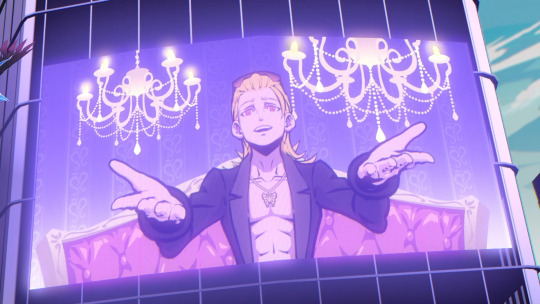
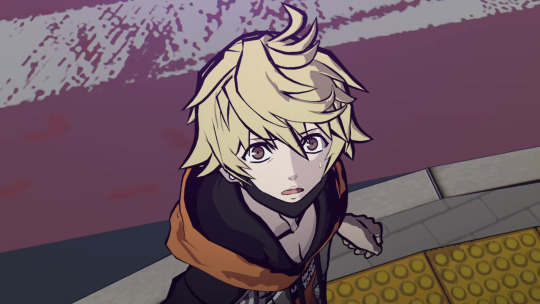
■ Team Battles
Turf Wars: Scramble Slams
One kind of mission assigned in the Reapers’ Game is the Scramble Slam, a citywide turf war that has teams vying for control of various areas around town. Erase all the orange Turf Noise or take down the rival team members in an area to claim that location as your own.
In Scramble Slams, the fun lies in not only gaining control of an area, but also in defeating swarms of enemies to earn even more Scramble Points and exchange them for even better rewards. Chain together battles with regular Noise to max out your point-earning potential!
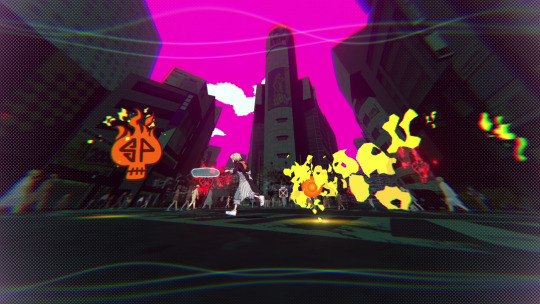
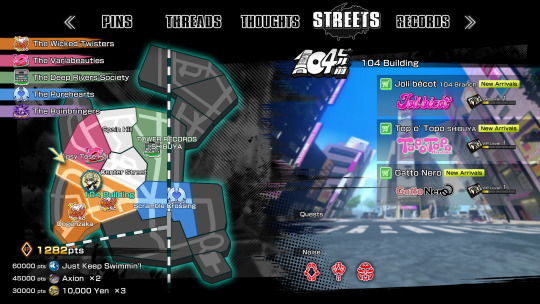
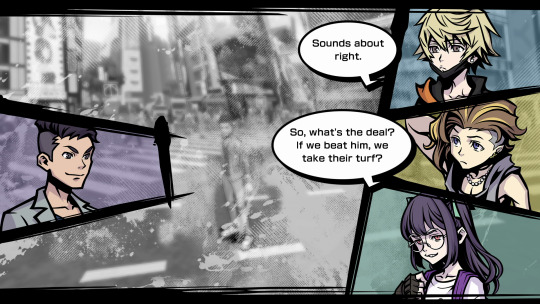
■ Characters: Ruinbringers

Known as the “strongest team,” everything else about them is shrouded in mystery: The Ruinbringers!
Susukichi (voiced by Max Udell [ENG], Natsuki Hanae [JPN])
“You kids must be the newbies! Oooh, fresh outta the box, ain’t ya?”
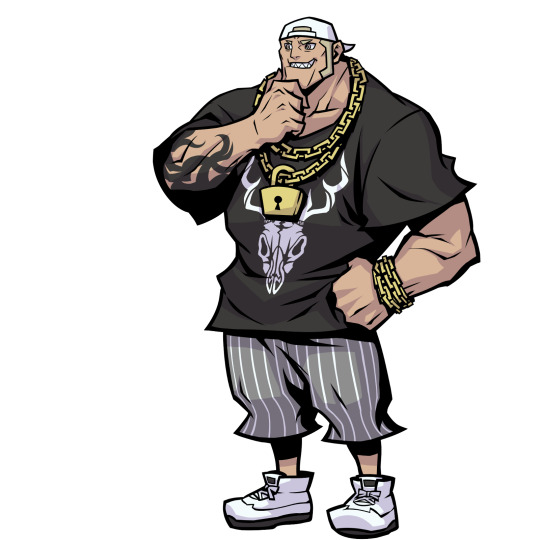
A Player in the Reapers’ Game, and a member of the Ruinbringers. While his impressive physique gives off an intimidating air, Susukichi is actually a bit of a chatterbox, rambling in his surprisingly high voice. Like the discs in beloved Reversi, he views the world in black and white.

Tsugumi (voiced by Ciara Riley Wilson [ENG], Yuka Ozaki in [JPN])
“I can’t lose… I must fight.”

A Player in the Reapers’ Game. Although she is a member of the Ruinbringers, she barely interacts with others and does not talk to anyone. Contrary to her waify appearance, she possesses powerful psychic abilities and a perfect record against other Players. The stuffed animal she carries resembles the mascot of Gatto Nero, a new brand that’s all the rage in Shibuya—but her plush pal apparently predates the establishment of said brand.

■ Characters: Deep Rivers Society

A group of river enthusiasts whose game-plan is to survive by being cautious and steady-going: the Deep Rivers Society!
Fuya (voiced by Adam Gold [ENG], Yoshiki Nakajima [JPN])
“You can row, row, row all you want…but you won’t go gently down this stream!”

A Player in the Reapers’ Game who got sucked into the action while taking a stroll in search of Shibuya’s most exquisite culverts. Despite being the de facto leader of the Deep Rivers Society, he is quite cowardly and not one to normally take charge. However, his aversion to conflict is the reason he’s managed to avoid dropping out of the game so far, so his “flight-over-fight” approach has served him surprisingly well. He holds a store-bought map of the city in which he’s hand-marked his favorite culverts.
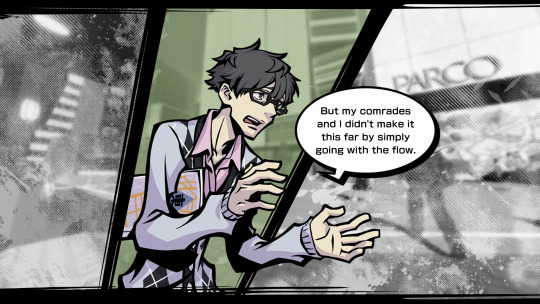
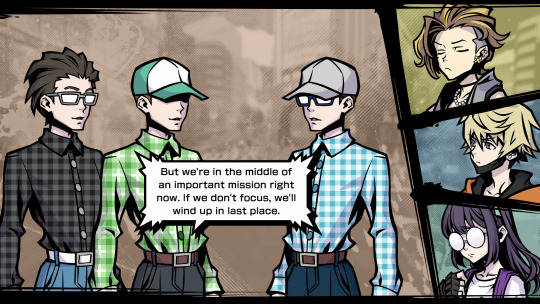
■ Characters: Variabeauties

The super-stylish team with a passion for fashion and a skilled negotiator at the helm: the Variabeauties!
Kanon (voiced by Xanthe Huynh [ENG], Sumire Uesaka [JPN])
“That may work on the other girls, but I’m a little sharper.”
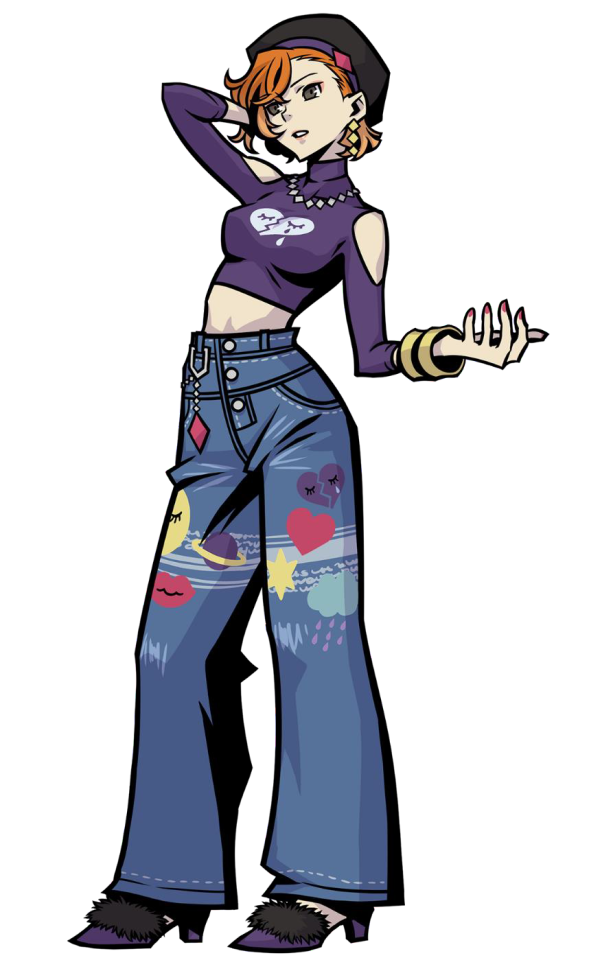
A Player in the Reapers’ Game and the leader of the Variabeauties. Both kind and captivating, Kanon gives “Rindy” and his teammates a crash course in the rules of the Game. Her beauty also belies a cunning side that reveals itself when the situation warrants. What she lacks in impressive psychic powers, she more than makes up for in wisdom, which has helped her survive the Game thus far.
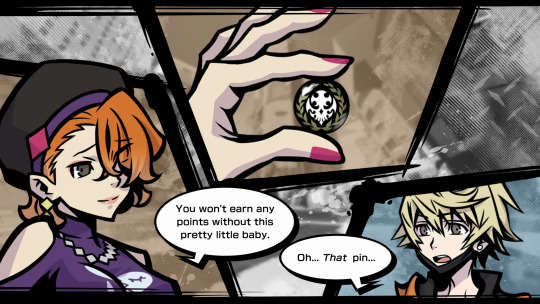
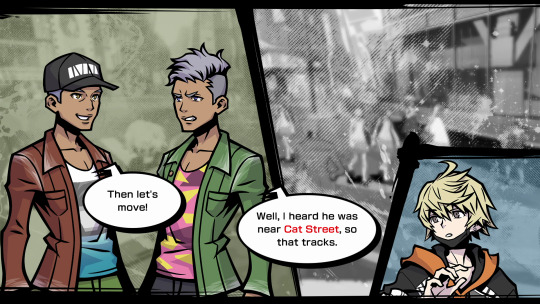
■ Characters: Purehearts

The social media-savvy team taking the game by storm and using their positive thinking as a weapon: the Purehearts!
Motoi (voiced by Nick Thurston [ENG], Wataru Komada [JPN])
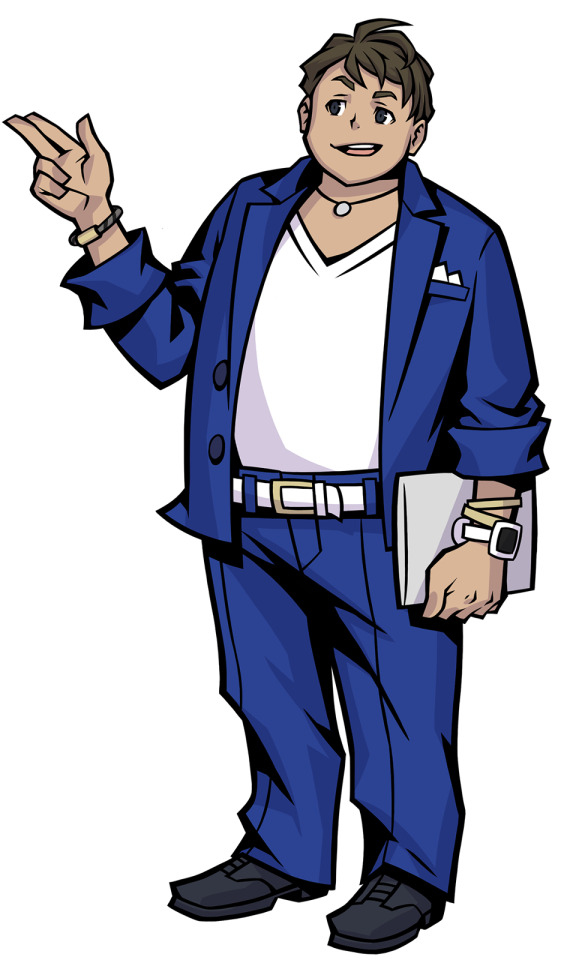
“I’m prepared to help out, of course! The more people working together, the better the resultat.”
A Player in the Reapers’ Game and the leader of the Purehearts. His winning smile and poetic platitudes give off good vibes only, even though his superficiality and frequent use of “fancy” words can rub some people the wrong way. Nevertheless, his magnetic personality has proven quite attractive, amassing him a large number of followers.
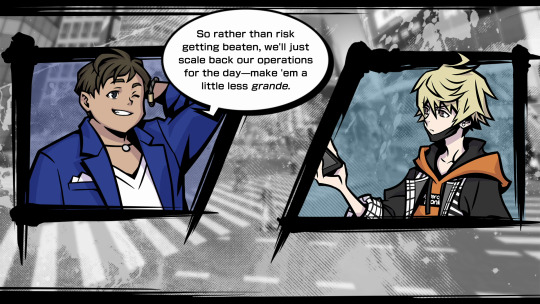
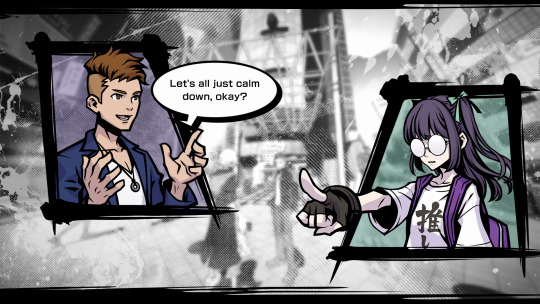
■ System: Threads
Rindo and his teammates can increase their HP (Health Points), ATK (Attack) and DEF (Defence) by wearing threads. There are five categories of fashion items you can equip: headwear, tops, bottoms, footwear, and accessories.
In addition, threads have abilities that are useful in battle. If the character equipping an item has enough Style, its ability will be activated and its effect unleashed. Spruce up your fashion sense and unlock the true power of the threads!
—There are no restrictions when it comes to equipping threads, so you can make whichever character you like wear any fashion item. However, some abilities will only activate when the corresponding item is equipped by a specific character.
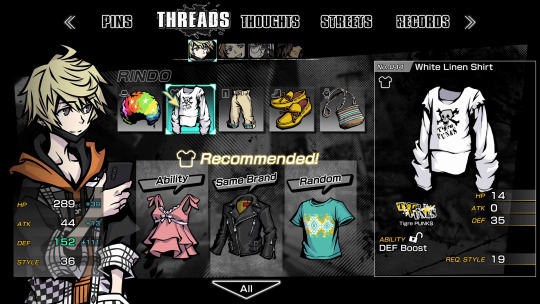
■ Shops
The city of Shibuya is dotted with a wide variety of shops. There are over 40 establishments to visit, with some selling threads and pins, some providing delicious food and drink, and some offering collectibles like CDs and books.
Each shop attendant is unique, and they reveal a little more of their personality with each visit. Stop by a shop often enough and you might even earn yourself some VIP perks!
—Look for SHOP icons to find places where you can shop and eat! You can also enjoy shopping at stores which exist in the real world such as Taiseido and Tower Records.
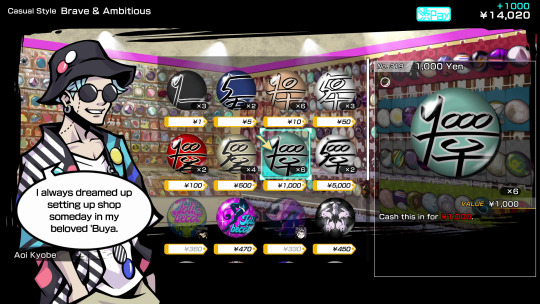
—Pay with the contactless payment system “ShibuPay.” Sell the pins you gain during battle to top up your balance.


■ Shops and Brands
The style of clothes and accessories in fashion shops changes with each brand. The number of products will increase as you progress through the story and meet various conditions, so be sure to pop into your favorite shops every now and then. A few of the game’s boutiques are featured below.
—There are over 270 types of fashion items. Assemble ensembles around your favorite brands!



Top o’ Topo
Cute and girly clothes that are popular with younger crowds. Has its main store in Harajuku and another branch in Shibuya.

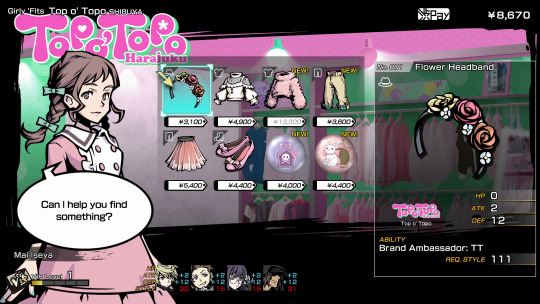
Joli becot
A sexy yet stylish brand for women that also features some cool pieces for men. Sometimes called “JB” for short.

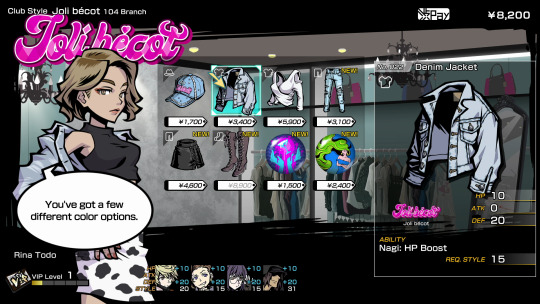
Tigre Punks
Long-standing punk fashion brand beloved throughout Shibuya. Their edgy designs are tough in many ways.

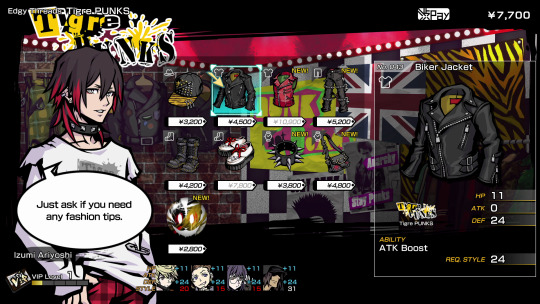
■ Restaurants
Another great thing about Shibuya is its wide selection of restaurants! Choose from a variety of dining options like guilty fast food pleasures, succulent meat dishes, healthy veggie soups, and parfaits packed with cream and fruit. Eating improves your basic stats and is essential for Rindo and his teammates’ growth. If you want to survive the Reapers’ Game, watch what you eat!
—There are over 90 types of food. Savor all the fine dishes Shibuya has to offer!



—Rindo and his teammates’ reactions during food scenes in the restaurants are also a treat. Their moods are different when they eat something they like versus when they eat something they don’t.
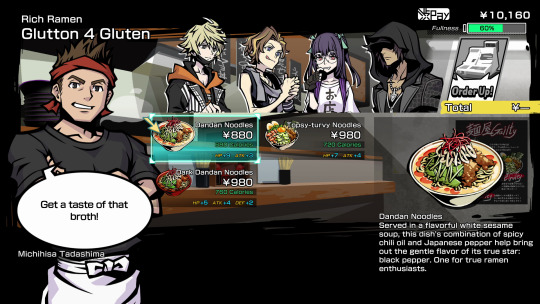
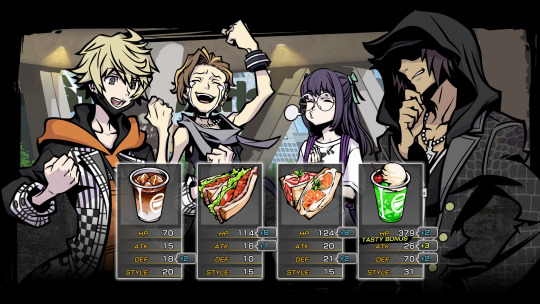
■ System: Remind
Fret’s unique psych: Remind!
Fret’s unique psych, Remind, jogs people’s memories and helps them to remember things they have forgotten.
A minigame will start when Remind is activated. Tilt the left and right sticks in the correct positions to reassemble the scattered memory. Put all the pieces in the right place to complete the reminder!
—Use Remind on a Reaper who has forgotten the mission he was supposed to give out.
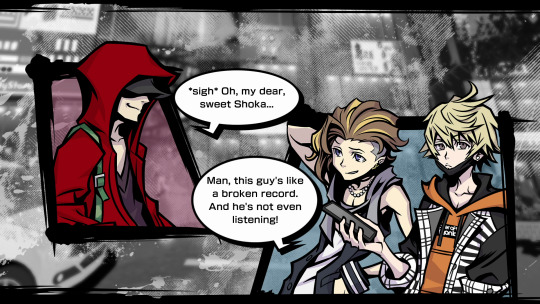
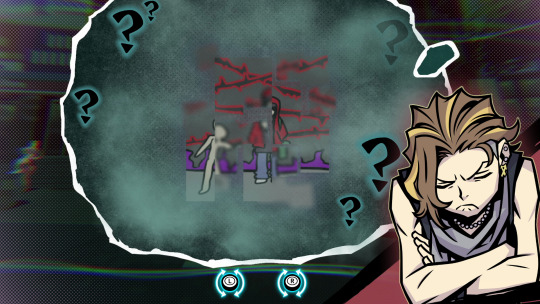
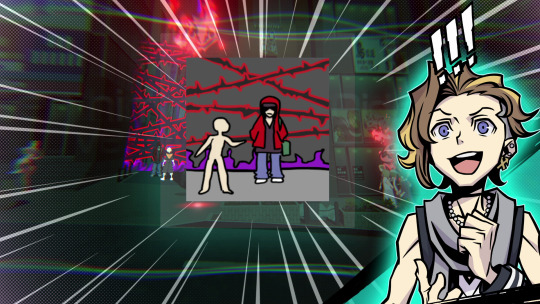
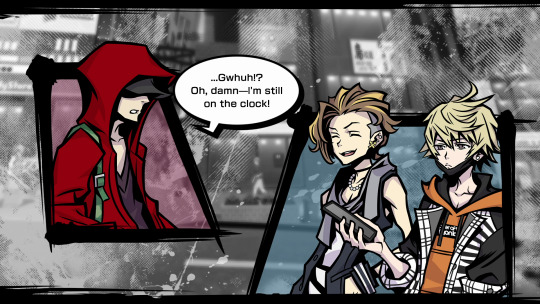
■ Locations
Rindo and his teammates travel to all corners of the Shibuya area over the course of the Reapers’ Game. Revisit familiar spots from the previous game such as Tipsy Tose Hall, and discover new locations like Shibuya Stream and the iconic Takeshita Street.



■ Pins
Classical Cacophany
A pin that enables the use of “dart bombs,” which shoots arrows that explode after a short time. By shooting a certain number of arrows quickly, a large explosion will occur immediately.
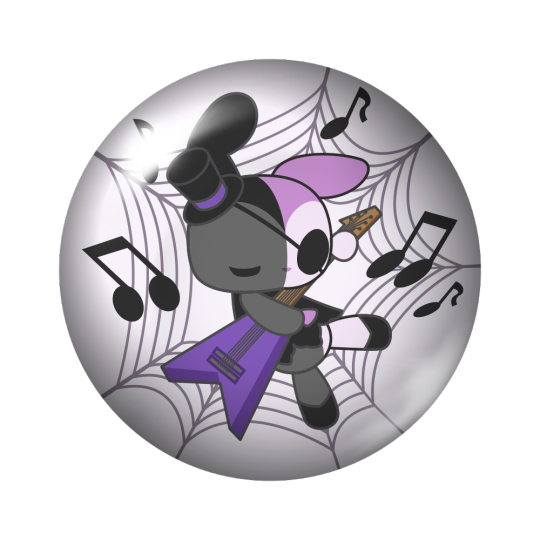
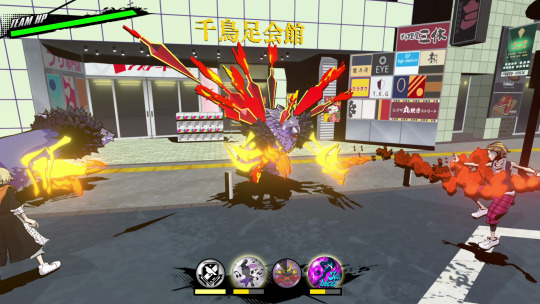
ShoGun: Void
The “entanglement,” which generates a chain in a straight line that damages and restrains the enemies it touches, plays nice with other psychs.

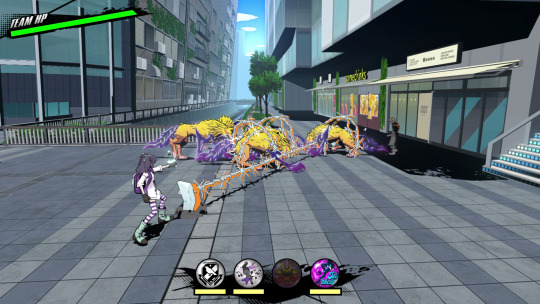
The Great Volancic Escape
Set a timed explosive at your feet with the “Time Bomb” psych. Figure out when to detonate the bomb and follow up with an attack.

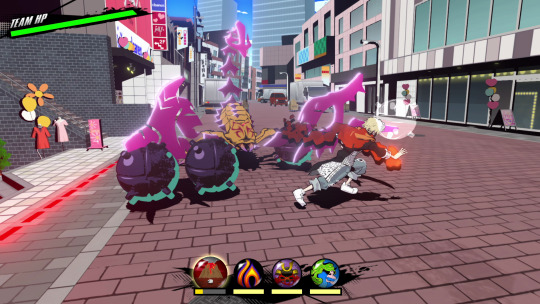
NEO: The World Ends with You will launch for PlayStation 4 and Switch on July 27, 2021 worldwide, followed by PC via the Epic Games Store in Summer 2021.
#NEO The World Ends With You#NEO TWEWY#NTWEWY#The World Ends With You#TWEWY#Square Enix#video game#PS4#Nintendo Switch#PC#Epic Games Store#long post#late post
14 notes
·
View notes
Text
Return the Flames - Chapter 1
All at Dead Bird Studios knew of Amos' (The Conductor's) ability. How the owl could suddenly erupt into flames if angered enough. When the studio first opened, Dominic (DJ Grooves) was told that Amos had his ability under control. Nothing to worry about. No possible loss of anything from an open flame.
A few years later however, and that control seems to have lessened to a dangerous degree.
It should have just been a simple, week long drive to fix the problem. It really should have been.
Dominic should have asked a lot more questions and should have been prepared for a twist ending.
_________________
Fandom: A Hat in Time Rating: General Audience Relationships/Pairings: The ConductorXDJ Grooves Warnings: Eventual depictions of violence, slow burn relationship, named characters, attempt of an accent, being hunted down, a race against time (sort of).
It’s amazing how one outside source could influence an entire planet and change it’s view. Okay, maybe the ‘entire planet’ might be an exaggerated size. But, big key players were involved with the overall growth. So, it felt as if the world shifted when the time wielding child left to race among the stars once more.
Mustache Girl, discovered to be named Mu when the dust settled, had seemingly disappeared. Her usual hideout had been cleared out. With no signs of her remaining there or found to be anywhere else on Mafia Island. There was a theory that Mu had hopped onto one of the many shipment boats and had left said island as soon as she could. If that was true, it would be nearly impossible to find her. No one could fully tell if this was a good or bad thing.
The Mafia boss had officially retired when he couldn’t find a new body to use. Apparently the price was too high to pay for someone to give up their own. Losing that intimidating edge and just being gross, he announced his leave and traveled to the nearby mainland. There he found his new calling: being the store manager to a small fish market operation. Apparently, no one wanted to argue about prices against a goo of a human being that survived in a jar. Between the harsh words and rather disturbing appearance, people lost their argumentative spark quickly.
The rest of the Mafia scrambled to figure out what to do with themselves. It took a lot of soul searching and late night conversations for a solution to be found. They reached the conclusion that they all worked better when they’re told what to do and decided to turn the island town into a high end luxury resort. Cooking Cat had taken the chief helm and taught a large team of Mafia members how to be proper cooks. It would be bad if a customer complained about food poisoning.
Subcon Forest, while still downright terrifying and with Vanessa a heavy threat over the citizens, had seen the number of lost souls consumed by that place dropped. The Snatcher had apparently changed stance on determining which souls were meant to be taken. Namely those who were weighed down by a lot of sins. If asked, he would claim it was due to those being more filing when eaten. No one had the needed bravery to really question the twisted spirit’s reasoning. So, more living beings started leaving the woods. Confused, with their souls still in place, and all at the cost of a high-five.
But the biggest change came from Dead Bird Studio. If one was interested in movies (which was a good majority of the planet) they knew of the rivalry that ran that place. Or did run that place. The Conductor and DJ Grooves announced, shortly after Hat Kid’s departure, that their feud was over. More or less. Everyone knew that years of animosity couldn’t be solved or swept under the rug, to be forgotten about overnight.
So, it was an difficult uphill battle to learn what it meant to actually work together peacefully. Between Conductor’s anger and Grooves’ rather smug attitude, it was a hard progress. Both directors used a lot of late nights to find even ground. After a few months, they had reached a level of comradery that couldn’t really be qualified as ‘being friends’. Business partners was probably the best title.
Which was still an achievement to marvel at, if Grooves was completely honest. But the worry of getting into a shouting match with Amos was now at the bottom of Dominic’s list.
When the studio had been open for the first few months, they gained the title as the ‘studio with the hot headed director’. Dominic seeing first hand how deranged the other could become. The penguin could chalk it up to first time jitters. After all, opening up a business in the same building with someone you deemed as a rival was not the most calming experience. Add on top of that the tense world of film making and Grooves was surprised he didn’t eventually turn to biting off a few heads when things went wrong. But as Amos’ anger seemed to grow, Grooves began to worry that the director was going to have a heart attack from his numerous outbursts.
What he was not expected was for the owl to suddenly have his ears erupt into flames . The only thing that pulled Dominic from his shocked state of mind when the sprinklers suddenly activated. All in attendance having to evacuate until the place was dried out.
Unable to ask Amos directly (and already knowing the director wouldn’t have answered his questions anyway) Dominic had gone to the Express Owls for answers. He had been told that their director suddenly creating flames was something normal to see. Amos even had occasions where he would actually have smoke rising off of him. The penguin asked how this was even possible. As far as he knew, this was not a normal occurrence, and working with someone who could burst into flames at any time seemed a dangerous factor. Especially if it became a worry they’d lose the studio because of this. But Dominic was assured that Amos had his ability under control. That day was just a build up of bad moments that tore at the owl’s patient until it was just released.
That didn’t mean Dominic didn’t start carrying around a small fire extinguisher whenever he had to be near Amos.
Amos, on his part, was not a bird who opened up about anything. So, he never explained to anyone why he had this ability, with the Express Owls just accepting the idea their boss could handle himself. And, true to their word, Dominic didn’t see that many open flames coming from the angry owl. During their early years that was.
Now, however, the worry had reached a new level of concern. Because Amos’ anger seemed to have suddenly grown. Even after the feud was put away. The control the other director had over the years seeming to have disappeared. Now the owl bursting into flames, full flames covering his body, when his mood was even. With another worry arising when he was around open flames and his anger made those grow dangerously. So much so, Dominic put his foot down on allowing open flame to be anywhere near the studio. Which annoyed Amos as now his movies lost a touch of authenticity. In turn causing the owl’s already short fuse to become shorter.
It had become a dangerous, endless cycle. One that Dominic had to intervene before things got too out of hand. Something he was going to take care of today. Because he was afraid if he waited too long, they’d lose the studio they’d just started to work together in.
Recording was done for the day and the studio practically empty as Dominic made his way to the Western-themed portion of the building. Asking a few lingering owls where their director was, he was directed towards Amos’ office. The partially closed door had light emitting from the cracks. Dominic gave his thanks before heading over. Raising his hand up to knock, the penguin paused hearing Amos’ daughter’s name.
“Amelia...no, listen… Aye, ‘m aware. But you’re in no condition ta take me… I know, I know… No, flyin’ is too dangerous. Ya know know I hate those death machines and there’s no easy exit for me ta take in case of… In case I have an episode.”
Dominic leaned against the wall, frowning. He probably shouldn’t be listening in.
“There are no tracks that run there. Besides, the train will be in use. I can’t change that just ta better me. No- no, that’s not what I mean… People rely on the train… I don’t know who ta ask. I don’t know anyone who would want ta travel that far.”
Amos laughed softly after a pause on his end. “Uh oh, someone sounds fussy… Aye, I'll keep ya up ta date as best I can… No, no, don’t ya fret about this. I’ll figure somethin’ out. Rest well Amelia, I’ll call tomorrow. ...Love ya too.”
There was the clatter of something heavy hitting the table. Dominic could only assume it was the owl’s phone being dropped. Braving his chance, the penguin pushed the door open. He found Amos, bent over the writing table with a discarded cell phone next to him. The owl looked in complete shambles.
Feathers were ruffled, randomly sticking out at odd ends. Some were even starting to turn gray. The familiar white button up had its sleeves rolled up over the elbows, the cross suspenders hanging limply from the black pants they were connected to. The similarly colored jacket was pooled at the Conductor’s feet.
“If ya have somethin’ ta say, come in and get it out.”
Amos’ growl broke Dominic’s stupor and the penguin closed the door behind him as he entered. “So-”
“How much did ya hear.”
“Enough that you know that you need to get somewhere with no reliable way to get there.” Dominic answered, pulling another chair towards the table.
“Didn’t know ya were one for eavesdroppin’. Hopin’ ta find a usable script for yer movies?”
“I’m going to ignore that last comment. I came to see if you were okay. Your ability is getting out of control and it’s becoming a concern. More than it’s been previously.”
“‘M aware of that. That’s what I was tryin’ to fix.”
“You need a ride to get there? To wherever this ‘fix’ is supposed to be.”
“Great deductive skills.”
Dominic let out a heavy sigh, tamping down the slowly rising anger within. “What I’m trying to say is that if you need a ride, I would like to offer my assistance.”
Amos sat up at that, ears perked up. “...What?”
“I will offer you a ride.”
“Ya don’t even know where I’m goin’!”
“It seems you’re desperate to get where you need to go. With your flares, it would be foolish for you to travel alone or in a confined place that you wouldn’t be able to leave when you needed.. So, let me help you.”
“...Are we...alright enough with each other ta be stuck in a car? Together? For so long?”
“How long is this journey?”
“I need ta get ta Starlight Peak.”
“I- That’s halfway across the planet!”
“Ya can see why this is a bit of an issue fer me.”
“Why do you need to get there?”
The owl huffed, ruffling his feathers further. “I’ll explain, if ya promise you’ll take me, and ya don’t ask further questions.”
“Those are pretty high demands.” Dominic crossed his arms.
“This...is not somethin’ I want a lot of people to know about.”
Dominic wasn’t ready for that answer. For as long as he’d known Amos, the owl has never been one to share any personal information. It took Dominic almost 8 years to learn he had a daughter and a few more months to know about his grandchildren. Which was really the only thing Dominic knew. Amos was short tempered but closed-lipped. Loud but private.
So, seeing him here, quiet and withdrawn, ears folded and arms crossed…
Dominic didn’t like it.
“I will take you and I will not share with anyone what you’re about to tell me.”
“And…”
“And I will not ask further questions.”
Taking that as an adequate answer, Amos sat up and faced Dominic properly. “I have this… ‘condition’ where I have this… I have fire burning in me.”
“Ah...I wasn’t ready for that. Wait, like an actual fire?”
“Aye, where did ya think my fire came from?”
“To be honest, I’m not really sure. Now that I know however, it kind of makes sense.”
“Well, that fire is burnin’ brighter everyday. More than what I can contain and control. There’s something at the peak that will help tamper that fire back down.”
“Tamper the fire down? What does that-”
“Ah, ya said ya wouldn’t ask questions!”
“Alright! Alright…” Dominic raised his hands in defense as Amos glared him down. As the owl sat back down, Dominic felt himself relax. “It’ll take us at least a week to get there and back.”
“Aye, ‘m aware.”
“We’ll need to shut down the studio for that long.”
“Ya worried about fallin’ behind on filming.”
“You wish. I’m more worried about the paparazzi. If they get wind of this, they’ll have a field day wondering where we’re going.”
Amos groaned, leaning back in his chair. “Peck, I forgot about that. Do ya think we could slip out without the peckin’ buzzards findin’ out?”
“You’re joking, right? The first day we don’t open, they’ll be hunting us down. If not the day before we depart. Speaking of, when do we need to leave? I’m assuming the sooner the better.”
“That would be ideal. But I do have a few things ta take care of before we do.”
“How about the day after tomorrow?”
Amos nodded to that suggestion. “Sounds like our best idea.”
“Best get to packing then.”
“Aye...and leave your peckin’ platform shoes here!”
“You just don’t care for style.”
“Do ya really want ta climb a mountain side in those shoes?”
“...Fair point.”
#A Hat In Time#discotrain#the conductor#dj grooves#s-creations#fanfiction#ahit conductor#ahit dj grooves#multi-chapter
26 notes
·
View notes
Text
D&D Worldbuilding: Cities
Planning
There are a few ways to plan out a city for your D&D campaign and they can be as detailed or as specific as you need. Figure out what you need the city for.
Main Hub: If the entire campaign revolves around this city, it’s important to flesh it out with detail so you can answer PCs’ inevitable questions and let them do what they want to do. Create complex relationships between NPCs, factions, economy, religion, and politics for the PCs to unravel each time they return to the city.
Major Location: This won’t be the only city the PCs visit, but they will spend some time here. Flesh out the city with its various districts and some relevant plot hooks and NPCs. Flesh out the city by working from vague to specific as players spend more time there. You don’t want to develop the place too much if the players end up leaving for another location.
Just a Visit: If the PCs are only visiting the area, you only need to plan or map out the relevant parts of the city and create the NPCs they need to encounter or are likely to encounter (like shopkeepers when they go to restock supplies). Plan out a description of the city with a few key landmarks and interesting features that give the city character if they wish to revisit it later.
Passing Remark: The players will likely never reach this city unless they work toward it. Come up with an elevator pitch with a one-sentence description of the city so the campaign world feels larger and maybe you will even entice them to go. What is the city famous for? What is its most prominent landmark? What are its relationships to other cities (trade/politics)? Once you answer these you don’t need to go any further until the PCs say “We want to go there”
Once you know how detailed you need to be, there are two ways to plan a city (two that I use, anyway). I will either create a list of traits to inform how the city looks, or create a map and use it to inform what’s in the city. Often, these methods end up playing with each other and lead to map reworks or second drafts, and that’s okay. Trust me, your first idea is never your best!
Map Draft
Let’s start with making a map because it’s more freeform and easier to explain. The first thing you decide when making a map is what the focus will be. This will often be a power center (like a castle or tower) or an identifying landmark (like a mountain, lake, great tree, giant shard of crystal, anything really). Once you have that, work fast and loose to imagine how the city springs up from there. Create masses of buildings (not individual ones) and create districts. Give the map an interesting and asymmetrical silhouette or shape (unless you’re going for a symmetrical look to emphasize a city’s lawful alignment). As you get more detailed remember that everything should highlight the focal point for your city map. As far as specific areas to fill in, here is a handy list of things to keep in mind.
City Defenses: In a world with giant creatures and cloistered kingdoms, some cities opt for walls, gates, towers, siege weapons, or other such things.
Commerce Center: Where does the majority of trade take place in the city? Are there different areas for this?
Districts: Most cities tend to divide into districts, like residential, commercial, industrial, governmental, religious, or military districts. Try to come up with unique districts that let them differ from districts in other cities.
Entry Points: Where do people enter and leave the city? There is most likely more than one way to do so (for the safety of the city).
Landmarks: Besides the focal point, your city should 100% always have something the players will remember to help them visualize the city. There can be other smaller landmarks, perhaps one in each city district.
Lower Class: If you have a lower class district, they will have smaller, more densely-packed buildings. They may exist both inside and outside the city walls, but tends to spread further from the power center.
Power Center: Whoever leads the city is probably going to have a big building or walled district or point of interest to display their station.
Upper Class: If you have an upper class district, they will have larger buildings, more leisure space, more monuments, and possibly be walled off from the rest of the city. They are more likely to be closer to the power center.
Water source: Many cities needs access to water to keep their huge population alive, so don’t neglect this.
City Features/Traits
Cities have a variety of traits that make them unique from one another. Determine the nature of these traits to help flesh out your city. A flavorful city has positive traits and negative ones; strengths as well as flaws.
Power Center/Government: Who holds the power in your city? Look at various forms of government and don’t limit yourself to just monarchy. Cities can have a democracy, republic, military, theocracy, or perhaps an arcane form of leadership. You can get creative with fantasy elements or add complications to your government to make the city unique: perhaps a strange sentient crown controls the queen, or a ghost of a king maintains control of their monarchy beyond death. Perhaps the oligarchy is a sham and a secretive cult really bends the city to its whims.
Complications don’t always means evil plots, but they can make things difficult when trying to influence the city as a whole. The city’s government isn’t necessarily its center of power. If the city’s senate is in the thieves’ guild’s pocket, the PCs may have to parley with the guild instead of the senate.
Economy: Cities aren’t often self-sufficient. They specialize in certain resources and lack in others, which leads to imports and exports. A mining city might have a booming metals and stone industry, exporting raw ores and gems or even refined ones with jewelry, but might lack in wood or food and need to import it from a neighboring town. These help define the city’s relations to other cities nearby. The city’s economy can also differ within its own gates. Consider the disparity of wealth in your city between the rich and poor.
How does the city spend its wealth? An interesting city will prioritize one aspect over others, or neglect one aspect in favor of others. Here are some things a city can spend its wealth on:
Expansion: The city seeks physical growth by buildings structures to expand its borders or establishing colonies in distant lands. Cities that neglect expansion might not suffer as much but may be content with their position on a global scale.
Infrastructure/Transportation: The city focuses on being as efficient as possible with well-maintained systems and structures in place. A city that neglects infrastructure might find themselves at odds with merchants and nobles who frequent the use of roads and bureaucratic systems, while residents are forced to tolerate the city’s difficulties.
Residences: The city focuses on making its housing maintained and affordable and expanding. The city wants people living inside it rather than commuting to the city. A city that neglects this may have slums or shantytowns and may be over- or underpopulated.
Military/City Defense: The city seeks to defend itself by maintaining its walls and guard towers, ensuring regular and frequent patrols and lookouts. They likely have a standing army that is maintained in case of attack. Perhaps their relationships with other kingdoms are strained. A city that neglects this is either in peacetime or is vulnerable. The streets may be rampant with unchecked crime.
Education/Technology: The city seeks to improve its people and its efficiency. In the case of a fantasy city, this may involve magic and magic items, but could also simply be a city attempting to revolutionize and move beyond other cities with something that improves an existing system. A city that neglects this may have masses that are easier to manipulate and may be stuck in the past.
Food/Health: The city focuses on its people’s wellbeing by ensuring they can get enough food and water to live and enough health care (either through doctors or priests) to persist. A city that neglects this may have very unhappy and unhealthy people. The masses tend to revolt when their society betrays them of these core things.
Extravagance: The city focuses on its appearance or the arts. The city may have a lot of excess wealth to spend on this or might rely on pilgrims and tourists for its economy and presents a gorgeous face to draw them in. Cities often neglect this first unless they are doing well or the rich seek to pacify the poor without giving up their station. Cities that do neglect this are often utilitarian with only a few striking monuments or important structures.
Military: What serves as the city’s military? Try to pick a focus for the city that takes advantage of its position. A coastal city will have a powerful navy to defend its docks and trade routes. A mountainous city may have fantastic archers and catapults to take advantage of their height. A city surrounded by plains will have a good cavalry to make quick maneuvers. A city in a wooded region will have infantry to navigate the terrain better than cavalry, and take advantage of the plentiful cover against arrowfire.
How large is the military? One city might have a daunting and powerful military presence while another might only have a standing militia. It depends on how much conflict the city faces, within and without its walls.
How does the city use its military? Are they actively defending the city? Are they campaigning in foreign lands? Are they attacking another city? Is the military used to keep its rebelling population in line? Consider this, as it will prominently let players know what the city and its leadership will live and die for.
Religion(s): Cities might have multiple religions or just one. Choose which ones feature prominently in the city, if any, and how much city life revolves around those religions. I won’t go into the detail of every deity and religion in the D&D universe, but consider that each has its own specific dogma, style, and portfolio that will influence how its worshipers act. A city that worships a chaotic-evil deity will differ vastly from one that worships a lawful-good one. A city with many deities will be different than both.
Figure out where each religion’s center of power lies in your city, and how much influence they have.
Shops/Taverns: Although they often serve as minor details in the grand scheme of a city, shops and taverns should be interesting and memorable for the players’ experience. Shop owners and innkeepers are an important reflection of the city, demonstrating how the populace views the city in which it lives. Moreover, filling a shop with items to buy and a tavern with quest hooks gives the players easy places to restock and find information when visiting the city. Put interesting characters in there to help characterize the city.
Landmarks: Landmarks define the setting and location and can even serve metaphorical or narrative meaning for the city. They help players visualize the city in their mind and remember it. Landmarks can be manmade or naturally-occurring, as long as it gives players groundwork to know where they are. The bigger and more unusual it is, the more interesting and memorable your city will be. Is there a giant shard of permanently-frozen ice from an ancient white dragon’s attack eons-ago looming as a grim reminder over the city? People tend to remember that sort of thing. Every city should be interesting, but just keep in mind not every city needs to have the same level of intrigue. If you have a main city the plot centers around, then go ham and go weird.
City Story: Cities can have stories just like any character, and when you start treating them like a character, it can have amazing results. Cities have backstories, conflicts, allies, and are filled with unique individuals who all contribute to the city’s traits.
History of the City: Cities aren’t built in a day. What happened to the city in the past to bring it where it is today? Disasters and war are useful historical tools that can be built around. The city recovers from such things but might never be the same. I have a city where a dragon’s attack caused a landslide that revealed an entry to the Underdark, and an entire city district built itself around it years later. History also adds layers to your campaign setting and makes it feel bigger and more unfathomable.
Factions: Cities draw people together, and people tend to group into communities. Those communities often have different goals that can come at odds with one another. This is where factions come in. Decide which factions are the most prominent in your city, establish their goals and ideals, and perhaps find a way to identify them. Figure out how they relate with other factions and what actions they have taken or plan to take to achieve their goals. Players love joining factions and it can give them an important stepping stone into the story of your world. Factions can include guilds, religious organizations, noble families, consortiums, or many such things.
Districts: Separating the city into more digestible portions can help players get to know it better and diversify it by forcing you to come up with unique areas of the city. Of course, don’t limit your city to such divisions. A commercial district can have a residential building, and an upper-class area can have an abandoned building housing squatters. The districts can even just be divisions in name only, much like street names. They may even be more memorable if they bear a unique name rather than simply “Merchant Ward” or “Warehouse District.”
What’s more interesting is creating something visually or culturally different for each district. Perhaps a district of a city named Towerhamme was built by giants from ages past and the colossal buildings have been subdivided by the humans now living there. Another district might consist of predominantly Thri-Kreen who worship Bralm (the goddess of insects and industry) and all speak a different dialect that mixes Thri-Kreen and Common. A district might lie in the dark underneath another district, with pillars as thick as trees holding up the buildings and streets above it, and come to be called the Night-Stone Forest. Not every district needs to be a didactic description of what’s in it.
NPCs: You don’t need to list everyone in the city, but make sure you know who the important people are. Name the people who are in power; those leading the government, religions, and factions. Name those important to your storyline. Think up interesting NPCs for the taverns and shops in your city. And most importantly, keep a list of random names handy so you can come up with them on the spot when PCs talk to people you didn’t prepare for. It may even be helpful to come up with interesting characters complete with backstories that the PCs can meet as allies or enemies. Just be careful with this, because you don’t know which NPCs your characters will become invested in until they do. The random throwaway character might be their favorite person to talk to while the most unique character that you delved into the deep history of was too boring for them. Make characters like crazy, but make backstories when you have to.
Foreign Relations: In terms of a city as a character, these are your city’s “bonds.” How does the city deal with other places? Economics and trading can be a large influence on how a city feels about another city or territory. If they rely a lot on each other they will tend to help each other out. If not, they might be indifferent or even enemies. Members of cities might feel differently than the city as a whole, but the city’s leadership most definitely will take some sort of diplomatic stance against other cities or territories.
A city’s diplomacy can be important to a storyline and add to the tone for the campaign. If two cities dislike each other, players will feel the tension if they travel between them. Friendly cities will be a different experience that carries less tension and more of an exploratory tone as the PCs wonder what awaits them.
City relations can also create opportunities for players to get involved, letting them ignite wars or resolve them can be important if that’s what the PCs want from the campaign.
4K notes
·
View notes
Text
Fighting Hate with more Hate. That always works, right?
“Sansa’s fans are so defensive of her because of the rest of the fandom demonize her and hate her for no reason.” - helenakey
So then the answer is to demonize the other women characters for no reason?
Of course there are going to be ‘fans’ that hate on a character for no reason, I’ve seen people post unnecessary and unreasonable hate on many of the characters, not just Sansa, and they can be as annoying, but they are not representative of the entire fandom. Not ALL fans are hating on her, and some are just looking at the character critically. I’m new to the tumblr metas (avoided for a long time due to the toxic reputation), but i’ve been on ASOIAF forums for a long time and there are plenty of Sansa supporters, even if she is still quite a polarizing character due to how people wish to interpret her... but Sansa stans on tumblr take it to the next level!
I’ve never seen this side of her fans before, or at least so much nearly every day, and subsequently the many rebuttals! And how often they like throwing other characters under the bus, often for hypocritical reasons. Like the OP yendany said, they ignore the trauma in other characters or dismiss it as not as bad, when it is often much, much worse. They criticize and attack other female characters to prop up Sansa ‘better’ survival skills, or attribute qualities to her she doesn’t possess (I see this a lot in fanfiction, before I realized the self-insert aspect), or use her age as excuse when all the main characters are young or even younger than her. The line porcelain to ivory to steel... can really apply to any character that has to grow up and face the harsh realities of the world... so it is really hypocritical to think Sansa is special in some way for overcoming her situation, all the characters are going through the same struggle, and many have it much worse. That is where I think so much of the anti-sansa stans come from, the hypocrisy and the tearing down of other just as deserving of sympathy/empathy characters, especially other women characters. It is a weird juxtaposition, that anyone with a reasonable sense of objectivity can pick up on and often do.
I mostly see it done against Arya and Dany, the two more prominent female characters in the books (thus the 2 who draw more focus than #3 Sansa?). The two female characters GRRM is telling a lot of his story through and spending a large amount of the text (right from book 1) to develop their growth as characters and showcase their strengths, intelligence, determination, fortitude, agency, cleverness, resilience and so much more. It’s as if because the other women are not ‘pure’ or see themselves that way and stronger in personality and character that somehow their suffering doesn’t affect them as much because they are tougher and didn’t let anything that happened to them stop them from growing stronger. They aren’t dwelling in victim-hood too long before they pick themselves back up and move forward.
And yet, they cheer when Sansa starts to grow stronger... Sansa’s growth has been much slower, we are moving into book 6 and she is just starting to gain a bit of agency, but she is still heavily under the tutelage of Baelish. We will see how far she gains in the next book and if she will break with Baelish by the end of it and be a fully independent player. But her development isn’t nearly on the same scale as Daenerys and Arya. That isn’t to imply that she isn’t going to be important, but it is clear from the text that she is not one of the main focuses for GRRM, or he would have developed her faster and given her more to do. We will see how much ground he can cover in 1-2 books, but there is only so much he will be able to accomplish and have it be believable, especially with so many POVs and story lines that he needs to develop.
I actually think their attempts to (over) defend her backfire, as so many feel the need to point out the falsehoods and misinterpretations, especially when they are wildly mean-spirited and completely refutable by the text. As I traverse through the ASOIAF metas I often come across fans metas writing rebuttals to other posts, to ‘correct’ their conclusion or ‘facts’. I’ve read so many of these they are starting to get repetitive, I also read some of the Sansa-stan posts they are rebutting and, yeah I can see why so many get upset. If you don’t like it when others tears down or dismisses Sansa, why do you think fans of the other characters wouldn’t comment when you go after their favs, especially so mean-spiritedly.
I don’t think I ever felt so much negativity towards the Sansa character until I had to read so many skewed and biased metas turning her into some kind of saintly YA Disney princess type that is just too good for this cruel world. That kind of character has no place in a series like this. You can’t help but want to point out the wild inaccuracies, and it makes me feel a negativity towards a character I didn’t feel negative to before. And I don’t want to feel negative towards her, she is a Stark and I root for the Starks, especially the kids. I often defended her against those who (I feel) just don’t understand what it is like to be a preteen girl, I relate to a lot of Sansa’s weaknesses and how she feels, especially at that age, and that is her appeal (to me) - the fact that she starts off very weak.
Sansa is weak both physically and mentally, she cares too much about rank, privilege, and what others think about her, her desire to conform, for everything to be proper, and properly in their place. She has the luxury to think that way because she is a rich, pretty, noble girl who ranks at the top of society, of course she sees life as great and never questions it... she is already at the top and winning from birth. This is why (I think) she is so hard on Arya, she messes with her idea of what is proper/good/right. Arya isn’t pretty and doesn’t try to be, she acts more boy than girl, she plays with dirty, smelly, poor children, etc... Those are all an embarrassment to Sansa and go against what a proper lady of her rank should do and care about. Once they head south, all the things Arya gets away with at home will stand out even more and reflect badly on Sansa, by association. So, she criticizes and distances herself even more, because she wants to join the elite glamorous world of the nobility.
The other girls don’t have those weaknesses, that is why they are seen as better able to cope than Sansa does. They grow quicker and stronger faster because they are not as inhibited by what the ‘rules’ are. This isn’t a criticism of Sansa, this is an observation and I think it is the entire point of including a character like her in the story. GRRM could have followed the original outline for her, but he wanted to ‘reform/rescue’ her character and give her (I hope) a better path back to her family and happiness. I think it is GRRMs way to show how young girls should NOT romanticize noble life or being pretty will lead to a ‘perfect’ life. That thinking of yourself as a lady or being a princess/queen isn’t what is important. That marring a ‘title’ (lord/prince) or a handsome face is not enough to lead to happiness. It is what you do with your life, and how you care about others and who cares about you - that is what is important. But some Sansa fans seem to miss that and want her to have all those thing and more... they want it both ways, her to learn all those things, and yet still get all those things... a beautiful princess life clear of the harsh actions to gain it and also a happy family married to the best, more heroic and honorable man - a fairy tale ending. And that is not ASOIAF.
They are reducing her entire arc to becoming a nicer, more pure, and pretty, prize for a man to love, marry and make their queen. If so, GRRM will botch the ending of his series and all the points he *seems* to be making thus far.
A major theme (to me) in Sansa arc is her lack of value in her home and family. Sansa (to me) is like the small town girl who can’t wait to leave her family / Winterfell behind and to move to the big glamorous city (King’s Landing) and become royalty. But once she got there wasn’t able to accumulate with its more complicated and corrupt realities of the court. Even setting the cruelty of Joffrey aside (he is an aberration, not a normal example), how everyone else ostracizes or ignores her (except the hound, and to some extent Tyrion - although he isn’t all that great). The way the Tyrells treat her before and after her wedding is much more representative of how typical court life and nobility behaves normally (I think). Sansa never saw the true value of being surrounded by people who love and care about YOU and whom you can trust and rely upon - until that is all taken from her. She slowly sees how the people at court are corrupt and deceitful under all the beauty and glamor she so aspired to only after being fooled more than once, and (to me) no longer wants any part of it, but is forced to play, thanks to Baelish.
This is a point I find many of her fan miss, they think Sansa is going to learn to play the game, destroy everyone with her cunning and beauty and rise to the top to be queen or a ruler - a path which will ultimately lead to down a very dark and cynical path... but somehow they think Sansa will be different, and her rise will be more like a Disney princess story, one where she will gain power without having to sink low to do it. That is NOT the kind of book GRRM is writing.
”I’ll make them love me.” - another childish statement, you can’t make people love you, you earn love and respect. And Sansa hasn’t done that once the entire series, she hasn’t made a single friend. No one is looking to follow or fight for/beside Sansa, save Baelish, and we all know that plan is doomed to fail, as he isn’t to be trusted or relied upon and wants to use her. I would even question her friendship with Jeyne Poole as it is clear she never saw them as equals, and that is not real friendship... more like Jeyne was a companion/lady-in-waiting type.
The few people who care about her (other than family) either are working on behalf of an oath to Catelyn, or have their own ambitions/sexual desires/pity for her and not necessarily care about her for herself because she was a good and loyal friend to them. Maybe this will change in the next book, but with Baelish keeping close tabs and guiding her, who knows how well she will be able to make any genuine relationships with others given all the secrets she has to keep.
Her only realistic path to leadership is through marriage and that is hardly giving her agency as a heroic rise to a leader of a men... more like sleeping her way to the top. Not something I want for Sansa, and I hope her ‘marriage’ to Tyrion works as plot armor against her being used like that.
Besides GRRM has kinda stressed that ‘real’ leadership comes from understanding people, observation, and experience, and not just from strategics marriage (Margaery, Cersei) or inheritance (Joffrey, Tommen, Cersei - she could prove the point all on her own :). Every leader in the book so far has to make compromises, make hard decisions and even make harsh, sometimes very bad decisions and live with those consequences. None of the characters in the series have escaped this as much as Sansa has, since so much of her story thus far is about her lack of agency, and being a pawn used by others (and to some extent she still is with Baelish). For her to make it to the end w/o doing anything and staying ‘pure’ and that is how she ends up on top, by essentially not taking many large personal risks, allowing others to do all the heavy lifting morally, mentally and physically. If winning means standing on the sidelines watching everyone else do the WORK, and just giving suggestive nudges here and there to have things turn out in your favor so you can just coast to the top (that is the Baelish way)... well, that is kinda the worst message GRRM could leave us with.
If GRRM wants Sansa to become a leader, she will have to get her hands dirty too, she will have to take great personal risks to gain power and accept the consequences good or bad that result, learn from them and move forward... otherwise it defeats one of the main points of his series and turns her into a simplistic cliche version of a character. Every character with a POV has gone through this, it is one of the major themes in ASOIAF, a more realistic, less easy way of looking at how you obtain power and learn by experience and a series of victories and defeats. Thus far Sansa has also avoided examining her actions and how they have affected her, she either never thinks about them, changes the facts to suit her better, or blames others without seeing the part she also played... I’m not blaming her, but her action did contribute to the situation... she never seems to realize this and I feel it is going to eventually hit her hard, she has to mature and grow out of her ‘unreliable narrator’ eventually, and it must lead to something for GRRM to make it such a large part of her narrative of coping with her trauma. I assume he wrote her this way for a reason and is going to do something with it.
I’m looking forward to a darker more realistic Sansa who has more agency and understanding, and I expect her to make her own mistakes and moral compromises (well she already has, but there was some coercion - but it also means she is capable of doing so) just like all the other POVs have had to do. I also look forward to her finally owning up to her past actions and how they also contributed to where she is now. If she can’t take some personal responsibility she will never grow. That is a part of having agency, understanding how your decisions and actions affect you and others.
I wish all the back and forth would stop, cause I’m tired of seeing it in my feeds, but I guess it has been going on for years - the same arguments/rebuttals - so I guess it will continue, even after we get the next book... I think only the completion of the entire series will end some of these arguments, but who knows - after some of the meta I’ve read, there will probably be even more, lol.
Well, I wanted to comment and give my two cents, but it ended up being longer and I guess for me all this is still new and offsetting. I guess I had more to say that I thought, even though I edited A LOT out because I wanted to keep it focused. I’ve just started to dip my toes into this crazy platform, so I’m sure this is just the tip of the toxic metas that I heard can be found here... can’t wait to read the anti-dany metas... that is sure to fill me with a sad rage as well, i know the show did her no favors, sigh....
34 notes
·
View notes
Quote
LEEDS, England — Jack Charlton, a soccer star who was a central part of the England team that lifted the World Cup on home soil in 1966 and who would later go on to transform Ireland’s national team as a manager, has died. He was 85. His family said in a statement issued on Saturday that Mr. Charlton had “died peacefully” the day before at his home in Northumberland, in northern England. “We cannot express how proud we are of the extraordinary life he led and the pleasure he brought to so many people in different countries and from all walks of life,” the statement read. Mr. Charlton had received a diagnosis of lymphoma last year and had suffered in recent years from dementia, according to the BBC. Leeds United, the club where he spent most of his career, said in a statement that it was “deeply saddened” to learn of his death, describing him as a “club legend.” Mr. Charlton spent all of his playing career at Leeds, making 773 appearances for the club as it was transformed from a makeweight into one of English soccer’s powerhouses in the 1960s and ’70s. It was his international career, though, that cemented his legacy. Mr. Charlton was born in Ashington, a mining town in Northumberland, in 1935, the eldest of four boys in a family of famous soccer stock: His mother, Cissie, was a cousin of Jackie Milburn, a famous striker for Newcastle United. Though Mr. Charlton started work in the town’s colliery as a 15-year-old, he left soon after, deciding to take up the offer of a contract at Leeds. One of his younger brothers, Bobby, would make a similar journey three years later, leaving Ashington to join Leeds’s great rival, Manchester United. Whereas Bobby, widely regarded as one of the finest players England has ever produced, was a powerful and prolific scorer of goals, Jack was a towering, imposing and gnarled defender. Together, both were part of the team that led England to its first, and thus far only, World Cup victory in 1966. In the final, England beat West Germany 4-2 after a long, grueling game. After congratulating Geoff Hurst, who had scored the decisive goals, the Charlton brothers embraced, and Jack sank to his knees, providing one of the defining images of the victory. “I don’t remember if I was saying a prayer or if I was knackered,” Mr. Charlton would say later. After his retirement as a player in 1973, Mr. Charlton coached Middlesbrough, Sheffield Wednesday and Newcastle, his hometown team, as well as applying to take charge of England in 1977. He never received a reply. Instead, almost a decade later, it would be in Ireland that the second act of his professional life reached its climax. Under Mr. Charlton’s aegis, Ireland qualified for the 1988 European Championship and the World Cups in both 1990, in Italy, and in 1994, in the United States, playing a style that was rudimentary, but effective. Mr. Charlton once admitted that his team’s strength was “stopping other people playing” soccer; once, he threatened to substitute a player who dared to pass the ball short. That did not diminish the affection in which he was held. Mr. Charlton was credited with turning Ireland from one of European soccer’s minnows — until he took over, it had never previously qualified for a major tournament — into a rising power, a transformation that foreshadowed the growth of the Celtic Tiger economy in the 1990s. “He changed everything about Irish football,” said Ray Houghton, one of his former players. “His legacy is absolutely huge.” After he retired from the role in 1995, Mr. Charlton was made a freeman of the city of Dublin. Prime Minister Micheal Martin of Ireland wrote on Twitter that he was “saddened to hear of the passing of Jack Charlton who brought such honesty and joy to the football world.” The Football Association of Ireland said the country had lost “the manager who changed Irish football forever.” Mr. Charlton is survived by his wife, Pat, whom he married in 1958, and by their three children: John, Deborah and Peter. As much as his achievements, both as a player and a coach, it was Mr. Charlton’s character — “larger than life,” as Mr. Houghton put it — that endeared him to players and fans alike on both sides of the Irish Sea. Mr. Charlton’s love for the outdoors — hunting, shooting and fishing — never waned, and he encouraged his teams to bond as much as possible, advocating the health benefits of Guinness over beer. He had an ear for an anecdote and an eye for a one-liner, all delivered in the distinctive Northumberland brogue that he never lost. During the 1990 World Cup, Mr. Charlton had taken his Ireland squad to the Vatican to meet John Paul II. The pope, an amateur goalkeeper in his youth, had struck up a conversation with Ireland’s goalkeeper, Packie Bonner. When Ireland was eliminated at the quarterfinal stage — by Italy, largely because of a shot spilled by the Irish goalie — Mr. Charlton did his best to console his players in the locker room. He told them that they had exceeded expectations and done their country proud. As they packed their bags, ready to fly home, the mood somber, he turned to his goalkeeper. “And by the way, Packie,” he said, “the pope would have saved that.” Rory Smith reported from Leeds, and Elian Peltier and Mark A. Walsh from London. The post Jack Charlton, Soccer Hero in England and Ireland, Dies at 85 appeared first on Shri Times.
http://sansaartimes.blogspot.com/2020/07/jack-charlton-soccer-hero-in-england.html
1 note
·
View note
Text
Unusual RPG combinations
I like to tinker with mixing and matching rpg settings and systems. I will try to collect the ones I'm most fascinated with. I haven't found the opportunity to actually try any of these combinations, but I guess it doesn't hurt to put them out there in case someone finds any of them interesting.
Shadowrun redux
Setting: Shadowrun
System: Blades in the Dark
I adore Shadowrun. It takes all the bleakness of reality, amplifies it, but also mixes it with a lot of magic and wonder. And if you read the books selectively, even with hope.
But playing it can get convoluted, especially if your group is prone to overplan. And we know that plans always go sideways. There's no such thing as a milk run. Spending an hour on planning can be annoying in itself. But it's extra painful if it has to be thrown out the window in the first five minutes of execution.
Enter Blades in the Dark that instead of planning ahead encourages to use flashbacks on the spot to reveal how you prepared in advance to get past an obstacle. That makes pulling off daring heists a lot more easier for the players. Infiltration is way less stressful on the player if they can make up any forged backstory on the go, and do a flashback to make sure it's believable. There's still some minimal planning, but it's practically just setting the starting scene of the run. You don't have to specify anything beyond that.
The concept of crew from Blades also fits nicely with Shadowrun. It can tell the GM what kind of runs the players prefer, and gives the players the ability tospecialize their team. Blades was created for a different level of technology and magic. But it mainly focuses on the hierarchy of the criminal underground, and that translates easily even to a modern world. So I expect the same crews to work with Shadowrun, but more thematic options could be added to tie it closer to the sixth world.
The concept of hunting grounds should be reconsidered. In Blades it means a specific neighbourhood the characters are more familiar with and usually target. In Shadowrun it makes more sense to make it a specific scenery they usually operate in. For example it could be a specific megacorporation they often go up against, or a type of gang that's common in the sprawls they operate in.
Blades also offers a nice subsystem for handling reputation, growth, notoriety, and even stress and trauma between runs. Incorporating a specific vice for each PC also seems completely in line with Shadowrun's concept.
The biggest difference will be in character creation. Blades' system is more abstract than Shadowrun's. In Blades you have to pick a specific playbook for your character. I think that's OK. While Shadowrun allowed building characters skill by skill, it always encouraged working toward specific archetypes like face, rigger, or adept. Your playbook determines your starting stats, but you can still somewhat specialize it. Blades also allows crossing from a playbook to a new one, but that's long term character advancement.
Adding some elements of Shadowrun might not be trivial. Spirits could be more or less handled as the ghosts in Blades. But magic and technology would have to be specifically addressed. Some of it could be treated like fluff, making it mechanically irrelevant whether your efforts are more effective because of training, because of an implant, or because you are infusing them with magic. But at least mages, riggers and deckers would probably need their own playbooks.
Twisted Houses of the Drow
Setting: any fantasy setting with drows, but I have a specific campaign idea for Spelljammer
System: Houses of the Blooded
This is a re-skin of Houses of the Blooded. The ven and the drow have different values and cultures, but I think they share a similar style. Decadence and intrigue runs deep in their societies. I'd replace the virtues (attributes) of the original game with corresponding vices. And each vice would be linked to a drow god instead of the totem animals of the original game.
Instead of the romance mechanic there would be rivalry. It would work the same way, just with a different flavour. Drows could pick someone as a rival, driving each other to greater feats. Instead of creating art drows could develop schemes. Same as the art mechanic. The scheme could give a bonus to those it was shared with. Seasons, regions, holdings, and blessings would have to be reworked, but I think renaming them would be enough in most cases.
My campaign idea is for a group of drow renegades employed by the elven admiralty as covert agents. They would be sent for long term infiltration missions to places where surface elves are not welcome. Each of them would have an affiliation with a drow god as well, and each would have their own hidden agenda. It might even work if not all characters are drows. I could imagine one or two elf, half-elf, or shapeshifter mixed in.
If I ever got to it seasons of the campaign would include: Building up a career of piracy in space (remember, Spelljammer) to get on the good side of a notorious and elusive pirate king, and lead the elven navy to its hideout. Instead of holdings the players could manage trade routes they raid, and their ships. Another would be infiltrating a drow city to stop an invasion. I think this would be the closest to the original Houses game. And finally I'd drop them in a mission to arrive as inmates to Elfcatraz, the secret prison of the admiralty (named by one of my players) to find out who's really in control there.
Around Cerilia in 80 days
Setting: Birthright
System: Primetime adventures
This one is kind of cheating, because Primetime adventures is quite setting-independent. So I rather mean it's a better fit for the kind of stories I'd like to run in this setting.
Birthright's setting works on a comprehensible scale for me. Most fantasy worlds have gigantic continents with dozens of large countries. They are too large for me, and I end up with a vast countryside where everything's the same for weeks to go. But Birthright has a small continent, maybe more like a large island with five distinct cultural regions. And each of those regions have a dozen provinces, each province described with its own flavor. It's not complicated, but colorful.
I guess it was done this way to accomodate the strategy aspect of Birthright that was one of its main features. While the concept of ruling provinces sounds great, the setting really makes me want to have a game about just travelling through this world. Not with adventurers, but rather with tourists, merchants, travelers who are going there to see a foreign place, or do business with the locals, and not just to explore a dungeon that happens to be there.
Ever since I saw the Roman Mysteries TV series I've been particularly fascinated with the idea of having a bunch of kids as player characters who are brought along by one's aunt/uncle on business trips to foreign lands, and get into trouble there. For example a trip from a frontier barony to the capital city, traveling through the woods of wary elves, then sailing down the river, stopping in a few more interesting port. Or a journey to the magnificent kingdoms in the east, although there are many perils both natural, and man-made on the way.
Thinking in Primetime adventures terms each province or city could be a separate episode. And the peculiarities of the place could be used to decide which character's spotlight episode should happen there.
Even domains of awnshegh (people and animals infected by the power of a dead god of darkness, becoming "monsters") don't have to be off limits. Some of them were quite sociable, and even more ruled over people whose perspective could be interesting.
Crown of Wings
Setting: Council of Wyrms
System: Birthright's domain management
Council of Wyrms focuses on playing dragons from various clans who work together. Despite the central role of the council, and the politics between the dragon clans, Council of Wyrms didn't touch much on the actual politics and realm management. It was the same AD&D, just scaled up to dragon PCs.
But I think there's so much more potential in the setting. I could easily imagine dragons ruling the land, managing guilds, and churches, and building out ley line networks to cast spells affecting whole realms. So everything that Birthright's system offered.
The setting isn't fully fleshed out, but it lets us fill in the land with fantastic locations. Some cities and towns were mentioned at unusual places, full of various races. So players could run wild with ideas when they create their own domain. Should their be trade routes with a merfolk city, and underwater ley lines? Absolutely. Could there be a church based on promoting the halfling lifestyle? Why not?
And then there's the Council. Domain Power could determine the character's status in it. Regency Points, and Gold Bars could be used as bargaining chips.
But what should be its purpose? I have seen enough of the trope of warring factions who have to be unified against some common threat, maybe with a traitorous faction thrown in the mix. I mean it makes for a fine story, but I'm getting a little tired of it. This time I'd rather see a council as a way to trade, to exchange ideas, and to help everybody improve their own clan. It doesn't make for a strong narrative, but I think it's a more positive message overall.
I think the biggest restriction in the setting is that dragon clans are too homogenic. Like, each clan consists of just one kind of dragon. That doesn't help in putting together a game with diverse characters. The original game concept solved that by making the PCs agents of the Council who may come from various clans.
For a more political game we could introduce mixed clans. So the characters could be part of the same clan, while still coming from various places. Maybe they are outcasts or survivors who created their own clan. Or maybe their clan was open minded, and was located in a central place, so it naturally lead to it becoming more diverse.
Or we could say that they are from different clans, but their clans are neighbours and allies of each other. At least if you're like me, and you don't want to set the players up for PvP by putting them to opposing sides of a clan feud.
Custom Quest
Setting: Your long-running campaign
System: Fiasco
I think any campaign that went on for a while should be an easy source for creating a Fiasco playset for a one-time play. Fiasco is about nobodies trying to pull off something bigger than they are. It's about petty people, and half-baked ideas going wrong. And while that might still sound like your average adventurer party, here we know they can't win. They will be lucky if they don't end up in a lot worse situation they started in.
For convenience I will refer to the PCs of the original campaign as heroes. It's okay if they are not actual heroes. That happens pretty often. But they had the greatest influence on the campaign this one shot is based on, so we have to heavily rely on them.
So the player characters in this one-shot are probably just background noise in the original campaign. I think this is a great way to explore how the actions of the heroes might affect the common people in unexpected ways. Objects driving the character dynamics could be things the heroes brought back, created, or just used in a memorable moment. Maybe an artifact they sold off is making its rounds on the blackmarket, and someone sees an opportunity in it. Or evidence surfaced that could incriminate one of the heroes.
And it's not just Objects. Their shenanigans might have brought the unwanted attention of a powerful cult to the city. Or the local barkeep loathes the heroes because they trashed his place one too many times. And he's just looking for some idiots to exact his revenge. Really, just look for whomever the heroes might have ever slighted or aided to get a plethora of petty plots and strange driving forces in the community. This can give you the Needs and Relationships between the player characters.
Locations could be places well known by the players, preferably close to a place the heroes frequent. The heroes, and the more memorable NPCs could give some enjoyable cameos. And finally they could become part of the Tilt table to turn a bad situation worse in the middle of the game.
#tabletop rpg#fiasco#drow#Houses of the Blooded#Birthright#shadowrun#spelljammer#Blades in the Dark#Primetime Adventures#Council of Wyrms#rpg#rpg combos
7 notes
·
View notes
Text
“Kingdom Hearts II” revisited, Part VII
Little things can have a big impact, and a Twilight Town emptied of any signs of life makes for a very effective and foreboding beginning to the final legs of KH II. The continuation of the mystery surrounding Riku - or, more specifically, what King Mickey knows about Riku and why he won’t reveal it - is continued in a satisfying manner as well. That makes for another good point of comparison with later entries in the series; something like the return of Repliku in KH III, for example. That was thrown into the series more than a decade after that character’s supposed death, is only referenced when absolutely demanded by the plot, ends abruptly, and doesn’t have any logical - or narratively satisfying - continuity with what became of Repliku in R/R. By contrast, Riku and Mickey’s history in KH II was begun in the game immediately preceding this one and, while very much in the background, is referred to in big and small ways throughout the play time.
(Revisiting Twilight Town also has a great gag, with Sora and his friends incredulous at the deductions made by Hayner and his friends. Just because they happen to be right doesn’t mean they make sense.)
Once we start in on the road to The World That Never Was, however...my feelings start to get mixed.
I’ve learned over the course of this playthrough that Axel was originally meant to die at Roxas’s hands during the prologue of the game. As much as I don’t like Axel - and let me reiterate that I really don’t like Axel - I can’t regret the decision to keep around past that point, for reasons I’ll get into shortly. And wrapping Axel’s story up by way of a noble sacrifice, if a bit cliche, isn’t a terrible idea. But it is a more rushed and arbitrary sequence than I remember, with Axel’s appearance - and his decision to kill himself - just happening, without a strong motive. While it pains me to say this, more cutscenes with Axel - particularly concerning Kairi’s escape from him - would have done this moment a favor. Despite all that, I think this is more successful than not as an ending for Axel...one that should have been permanent.
(And did no one on staff remember the line “he was the only one I liked” when they decided to start working toward an Axel/Saix bromance?)
The return of Roxas leaves me with similarly mixed feelings. I like how cold and predatory Roxas’s attitude is - it’s a strong contrast with Sora, and indeed with Roxas as he appears in the prologue. I’ll once again save more detailed thoughts about Roxas for another day, so let’s just say for now I think that attitude speaks to why Roxas being subsumed into Sora is appropriate. But there is a big problem with this sequence: it’s only a cutscene. That this wasn’t a playable battle right out of the gate, given how pivotal a moment it is, is ridiculous, and if Final Mix did nothing else right, it fixed this huge mistake.
(And if you have Oathkeeper equipped at the time - as I always do, in any game that offers it, from the time I receive it - that cutscene is a little strange to watch.)
Stepping into the castle unloads a lot of story, for how (relatively) quickly it goes by, so it’s inevitable that there will be highlights and low points. Namine and Kairi finally meeting, and teaming up to escape, manages to be both. That the moment happens at all is wonderful, and both girls being prepared to fight Saix, unarmed if they have to, is a good touch. But these scenes take the old adage of “leave them wanting more” to an extreme, because we’re given only the barest of bones for what Kairi and Namine’s interaction could have been. Add in the fact that Namine’s origins, and the closest thing to an explanation for why she starts to fade from existence, are relegated to Ansem’s reports, and it’s very hard not to feel that she was cheated in the writing. She and Kairi were certainly cheated by the animators; their run cycle looks ridiculous. On the other hand, Kairi pulling back Riku’s hood is touching, and makes for a good reveal of an identity that most players would have figured out by this point, but is no less satisfying for that.
Every scene with Ansem the Wise in this game just reminds me all over again how incredible Sir Christopher Lee was, and how ridiculous they were to recast while he was still alive. The reveal for Ansem (another identity that should have been obvious by now) is well-handled, and he makes for an unlikely but effective partner for Mickey Mouse to bounce off of. But too much of Ansem’s story - his key turning points as a character - is left for the reports, and for his monologues. And the backstory given in that scene, and those reports, seems to be at odds with both the beginning of KH II and the events of R/R. Ansem speaks of Riku as though the two of them were working together, with knowledge of the other’s identity, for a long time, and yet the dialogue in their scenes in the prologue suggests that DiZ, at least, isn’t sure exactly who his cloaked ally is. And Riku leaving King Mickey because “Xehanort’s Heartless was still inside his heart, troubling him” seems to negate the growth Riku had in R/R. Just having Riku and Mickey get separated involuntarily would’ve been fine, I think.
I didn’t remember KH II vanilla engaging in any sequel baiting outside of the secret ending, but there is at least one line of dialogue that does so: “you don’t look like half the hero the others were.” Compared to later entries in the series, it’s a minor and innocuous tease, and if this were the end of the series, one could always justify it by assuming Xigbar was referring to the unnamed and distant Keyblade wielders that Triton alluded to in KH I. The scenes surrounding the boss battle with Xigbar are largely solid, with a fantastic reintroduction for Maleficent, great material for Kairi, and a pretty fun fight in its own right. Sora and Kairi finally reuniting is a very sweet moment - not just in the scene itself, where they embrace, but in the little details following. Kairi’s dialogue box remarking on how Sora kept her charm comes to mind (and made me doubly happy that I stick with Oathkeepr.) Kairi being the one to bring Sora and Riku back together is a wonderful idea too, though I’m one of those people who finds Sora’s reaction a little forced. I wouldn’t say it’s any more overdone than, say, the fake-out with Goofy in Hollow Bastion, but it is a bit much.
Where this section of TWTNW starts to slip up a bit is in its determination to keep the player from ever having Sora, Riku, and Kairi together in a party. How and why various characters don’t fight alongside Sora in this game is often arbitrary, and I think it’s probably impossible to avoid a few forced choices in a game this long, but it really is absurd to never put that trio together for a battle. If you check in with Kairi whenever there’s a chance to pull up dialogue boxes, you’ll get lines that all say more or less the same thing: she wants to be involved in the action from now on and be at Sora’s side in danger. This is why she’s a character that I get upset for, rather than at, because the writers take the pains to establish her as someone with the desire and the will to be an active participant in the adventure (and, apparently, the ability - she gets the hang of that Keyblade pretty quickly), and then force these circumstances that deny her the opportunity.
Having said that, the two boss battles leading up to Xemnas are...what they are. I can’t say there’s anything wrong with them, but they aren’t my favorites. To the extent that I have memories of Luxord from the first time I played this game, I’m pretty sure I disliked him, just for how hard I found it to get the timing right on his games. Saix is a fair challenge, but a little tedious IMO. His fight also leads into one of the most ridiculous moments for Sora in the game - his not remembering that he became a Heartless. Y’know, that pivotal moment in the first game, the choice he made himself for the sake of others that he was then rescued from by Kairi, and discussed with her after the fact as solemnly as two young teenagers could. Anybody could forget that.
But those fights, and the Organization’s graveyard, do bring me back to why I’m glad Axel wasn’t killed off early. Because this is the point in the game where I realized, back in the day, that Organization XIII is kind of pathetic. And I don’t mean that as a point against them as villains, or against the game. What I mean is - if you ignore the bullshit pulled by DDD and just take KH II on its own terms, the Organizers are ultimately little more than glorified Dusks, devoid of real emotions or conscience, aware of everything they’ve lost along with their hearts but careless towards the suffering they cause in an effort to reclaim those hearts that is, in the end, futile. The members’ own self-serving and predatory natures damages the Organization almost as much as the efforts of the heroes, and by the time Sora appears to clean up the mess, the Organization is already on its last legs. Axel’s attempts to get Roxas back by baiting Sora with Kairi - a ridiculous and ill-thought plan - is the whole Organization writ small, and offers a good preview for their own fate. And it’s another reason why I never wanted or needed more information about any of the Organizers as individuals than what we got. Going just off of KH II (and CoM), there wasn’t much left to any of them, and that seemed part of the point.
That Organization XIII is such a hollow, empty, and doomed shell gives the villains some pathos - a more earned degree of pathos than DDD and KH III would attempt to provide them - but it also means that the heavy-handedness of Xemnas’s dialogue isn’t necessary. A fair amount of what he was saying is self-evident. I also find it bothersome that no one calls him out on exactly what the Organization’s plan was, and that the person who gets the closest is Riku - not Sora, the character who had a much less wordy but far more impactful verbal exchange with Ansem SoD in the last game that expressed the contrast between knowledge and wisdom beautifully. That can’t be said for KH II; as I said, that bit of dialogue before the first Xemnas fight, and Xemnas’s conversation with Ansem are over-written. But they aren’t terrible either.
The events leading up to that first fight with Xemnas have many great moments. The image of Nobodies dancing in a shower of hearts is genuinely creepy. Ansem’s farewell to King Mickey is touching, and offers yet another effective character sacrifice that should have been permanent. And the final scene for Maleficent and Pete is fantastic. But Riku seems to be treated by the game - certainly by Ansem the Wise - as the group leader once he gets his body back, and I’m not sure how I feel about that. He was a crucial figure “behind the scenes,” as it were, in reviving Sora and sounding alarm bells. But Sora is the one who’s at the point of action, rescuing worlds from Heartless and Nobodies, and taking out the majority of Organization members. He’s the one who’s been used by the Organization to do their dirty work, the one who fought his way to the castle to save the others and, not unimportantly, the one we play as throughout the entire game. He’s also arguably the person most owed an explanation for what happened over the past year. I can’t necessarily fault KH II for that - it isn’t as though they have time to sit down and regale him with details about the events of CoM. It’s more a failing of later games that he never gets appraised. But that he, and everyone else, just seem to fall in line, and that Riku’s the one who knows what to do (not that it isn’t obvious)...I just don’t know.
I left off right before stepping into the final door, so this playthrough’s not over yet. But next time, we won’t be looking at the finale of KH II, or finally getting into my assessment of Roxas. There’s a Final Mix out there for this game I’ve never gotten to play, and it’s about time I took a look at everything they added...
3 notes
·
View notes
Text
Final Fantasy I review: a pragmatic evolution
Final Fantasy; one of the largest and most influential game franchises out there, and my personal favorite video game series. It’s kind of surreal to think that it started out as what was basically an unlicensed Dungeons & Dragons adaptation from a failing company that only approved it to try to top Dragon Quest, like so many others back then. For all the faults it had, like being so utterly buggy that it artificially increased difficulty through things like mages not actually being able to gain more power for their magic, and several spells not even working, period, it pulled through with an innovative team building system, a great soundtrack that would help cement Nobou Uematsu as one of the great video game soundtrack composers, and a much more developed exploration system compared to Dragon Quest, giving you access to vehicles like an airship. For this review, however, I shall be reviewing the PSP version of Final Fantasy I, which is quite a different experience, for reasons I shall tackle shortly. Otherwise, in we go.

Story
The story is about a world home to 4 elemental crystals of earth, fire, water, and wind, which once blessed the land and its inhabitants with peace. However, the Four Fiends, the Lich, Marilith, the Kraken, and Tiamat, have since corrupted the crystals, depriving the world of their blessings and causing the appearance of monsters across the land. Despite the bleakness, however, the people keep faith in one thing: a prophecy stating that four Warriors of Light will appear one day to restore the crystals and defeat the Four Fiends. 400 years after the first of the fiends appeared, the Warriors of Light finally arrive at the town of Cornelia, where they are tasked by its king to save his daughter, Princess Sarah, from Garland, a traitorous knight, who has taken her to the Chaos Shrine. Afterwards, the king builds a bridge in gratitude, allowing them to skip over to the next town and beat up some pirates for their ship. Most of the “plot” of this game takes the form of fetching key items and chains of deals that stand in the way of you actually taking the fight to the Fiends, with the worst taking place right after getting the ship, involving almost every single area you can even visit at that time. It was probably a bit more interesting at the time, especially compared to Dragon Quest, but it’s a huge drag nowadays.
After killing all of the Fiends, the game decides to pull a twist: as it turns out, an evil force 2000 years in the past is still stealing the power of the crystals, originating from the Chaos Shrine. After traveling through a time portal, and killing all the Four Fiends again, the game pulls a bigger twist: they find Garland at the bottom of the shrine, having been sent back in time by the Fiends. Using their power to transform into the monster Chaos, he then used his power to send them into the present, creating some time loop that allows him to live forever. After defeating him, the Warriors of Light are returned to the present, having retroactively prevented any of the disasters from taking place, even ensuring Garland would never betray Cornelia. Doing this erases their memories of their journey, but the legend of it still lives on.... somehow. It’s not exactly a deep plot, but it can still be decently entertaining to go through, especially with the vastly improved translation of the later versions, which gives quite a bit of dialogue a surprising amount of charm.
Gameplay
The gameplay of Final Fantasy I is about the most standard NES era RPG you could get. You travel on a world map, exploring towns and dungeons and getting into random encounters, with the battle system also being a very standard turn based system, selecting all your party’s actions at the beginning of each turn, and having choices of attacking, using magic, using an item, defending, or attempting to escape. You gain the use of a ship, a canoe, and eventually an airship which pretty much invalidates any other form of travel for navigating the world map, though the ship can only dock at certain spots, and the airship can only land on grass tiles. This can pose a problem to a new player, as the continents are large and often force you to land farther away from your goal than you might expect. This is doubly bad as the game initially seems to lack a map feature, which can make navigation very difficult sense the map loops when you reach an edge of it. While there is actually a map you can access on the world map, which even displays the locations you’ve discovered, you can only bring it up by hitting a button combination the game never outright tells you, only being mentioned, and backwards, at that, by some brooms in an early area (it’s ok, it’s the home of a witch), which could be passed off as random nonsense if you’re not in the mood to think laterally.
The most interesting gameplay feature FF1 has to offer is its party building system. Instead of just gaining predetermined characters as you go on like, say, MOTHER, or only having one character, like Dragon Quest itself, you have 4 party members all the time that you select at the start of the game, picked from 6 different classes: the Warrior, the very standard physical fighter with great attack and defense, whose only real downside is being very reliant on equipment, the Monk, who is pretty much the opposite of the fighter, being a physical fighter who specializes in fighting unarmed, to the point of equipment actually lowering his attack and defense after a while, making him very cheap to use, and very broken after the first few levels. There’s also the Thief, which is bad on defense, but is good for attacking and has superior speed. The second half of the classes are magically focused. The White Mage specializes in healing and support magic, though they also have offense in the form of the Dia line of spells, which is effective against undead, and Holy, one of the major attacking spells of the series. The Black Mage, conversely, focuses on offensive magic, though they also have access to some very good buff, though they’re perhaps the most vulnerable of any class, with abysmal HP growth, at that. Lastly, there’s the Red Mage, the jack of all trades, master of none. They can use swords, have good defense, and access to both white and black magic, though they’re worse at all of those than the classes that focus on them individually, and can’t use most of the later game spells or equipment, though since you’re stuck with your chosen classes all the way, they’re never an outright burden, and plenty of people find them great regardless.
Aside from leveling up from fighting random encounters, you power up your party by buying equipment, or finding it in dungeons or other areas, and buying spells from towns. There’s 8 spell tiers in all, with all having 4 different spells per tier for both black and white magic. However, the spellcasters can only know up to three spells for each tier, with the red mage having to use those spaces for both white and black magic. Some tiers have better spells than others, with most spells more complex than simple healing or damage usually not being worthwhile. However, a lot of spells and equipment available around the time you get the airship is not actually usable by your party members, and this is because of a sidequest offered by Bahamut, the king of the dragons, to go within the Citadel of Trials and retrieve a rat tail. Doing so will cause for your party members to class change, aka basically promote into stronger classes. The Warrior becomes the Knight, the Monk becomes the Master, the Thief becomes the Ninja, the White Mage becomes the White Wizard, the Black Mage becomes the Black Wizard, and the Red Mage becomes the Red Wizard. This grants them better stat growth and access to stronger equipment and spells, and the Knight and Ninja gain white and black magic, respectively.
The NES version of FF1 is infamously difficult, but over the many ports, starting with the Playstation version, and most notably advanced with the GBA version, the game became much, much easier. Whether it be the fixing of damaging bugs or the ability to save anywhere instead of the world map, which, granted, was only sensible considering portable console, to switching the spell system from each tier only being usable a certain amount of times before needing recharging at an inn, something borrowed from Dungeons & Dragons, to switching to a much more traditional MP system, to just a general rebalancing of the classes, it makes for a much easier game to get through. Too easy, honestly. You gain experience much, much faster, so as long as you fight the majority of the encounters you get into, you’ll quickly end up overpowered. It’s very easy to reach level 99, and much of the best equipment is easy to get. However, I don’t think the easier difficulty, and the general simplicity of the gameplay, are necessarily bad things. On the contrary, it makes the game very easy to pick up and play through, and it’s surprisingly fun despite how simple the combat is. This, I think, is the saving grace of the game, and even if that doesn’t satisfy you, the bonus content added in the later ports are the highlights of the game.
The GBA version added four bonus dungeons collectively called the Soul of Chaos, unlocked after each Fiend you defeat. These dungeons consist of a set amount of different, and often wacky, floors that load in a randomized order. While the first two dungeons are fairly standard and short, stuff begins picking up with the third, and the fourth is a 40 floor gauntlet of fun and creative little challenges and maps. In addition, each dungeon contains cameo bosses from Final Fantasy 3-6, complete with remixes of their boss themes for the PSP versions. These include Shinryu and Omega, who are the hardest bosses in the GBA version, and Gilgamesh, one of the most famous characters in the series. All in all, these dungeons are actually really fun to go through, as long as you’re properly leveled, and are definitely refreshing compared to how most RPGs handle bonus dungeons. On that subject, however, is the Labyrinth of Time, added in the PSP version. It consists of time puzzles, 30 in all, though you only do so many in each run, that ends with a fight against a newly added superboss, and the usurper of the title of hardest boss in the game, Chronodia. The catch is that Chronodia has 8 different variations, with different rewards and bestiary entries for each, and which one you encounter depends on how many puzzles you finish in time, and how many you only complete after running out of time, causing a fog to roll in that saps you of your HP and MP, and allows random encounters while in the puzzle areas. While creative, the Labyrinth of Time is overall maddeningly difficult and not fun. This is one to skip if you value your sanity.
Sound & Graphics
The graphics of FF1, again, judging the PSP version, are actually really good. The characters look distinct, and the monster graphics especially are great, and represent Yoshitaka Amano’s designs for them very, very well.




The areas are also surprisingly well designed. From the ruins of the Chaos Shrine, and the complete version of it as the final dungeon, to the underwater ruins that house the lair of the Kraken, to, most notably, the flying fortress of the Lufenian civilization, home to Tiamat and far advanced compared to all the other locations, especially in the original NES version, where it’s a space station, of all things.
As for the music, it holds up amazingly. Aside from many of the most famous themes of the series, such as the Preude, themes like the town theme and the Chaos Shrine theme are amazingly atmospheric, and it overall still stands out as one of the best soundtracks in the series to me. Even if he wasn’t involved in the rearranging for the remakes, this was a significant step for composer Nobou Uematsu.
Conclusion
Despite how fond I am of this game, my recommendation rating depends. If you’re looking for a nice, easy to pick up RPG, perhaps as an introduction to the series, or to RPGs in general, I would give this a recommended. If you’re looking for much past that, however, I would give it a not recommended. As transformed as it is, it is still a very old game underneath, with unclear goals, very barebones gameplay systems, and with all the innovation it did have swept away over the years. Still, if nothing else, it’s a very respectable start to Final Fantasy. Until next time.
-Scout
4 notes
·
View notes
Text
I keep getting people who ask me what podcasts I listen to, what they’re about, and which I recommend, SO. Please note: these are solely my opinions, and your taste may differ from mine.
If you ever want more recommendations, check out Radio Drama Revival, which features all sorts of shows, singular and serial, and interviews with their writers and creators.
(This list is regularly updated. Last update 10/31/21.)
Top 3:
Archive 81: Dan is hired to organize some tapes about a very strange apartment building. Really ramps up in season 2. Horror. Good characters, interesting worldbuilding, intriguing plot, good voice acting, the best sound design of everything I’ve listened to so far. The whole package, really. (Ongoing.)
The Magnus Archives: An archivist for an institute of paranormal research reads aloud witness testimonials that turn out to be connected. The most tightly written podcast yet, perfectly paced, amazing use of framing device, fascinating world-building, wonderful slow-burn character development. Pay attention to the details in this one. (Completed.)
The Penumbra Podcast: There are a handful of stand-alone stories, but the two primary ones are a medieval-adjacent fantasy featuring knights facing monsters and a scifi detective noir story. Good breadth, and all the stories are fun and interesting, the characters endearing. Really excellent dialogue and genre play. (Ongoing.)
Great:
Alice Isn’t Dead: An anxious trucker is looking for her missing wife. Done by the Nightvale people but nothing like it. American Gothic variety horror. Lovely descriptions, a good protagonist, an interesting world, well-paced. (Completed.)
The Bunker: A black comedy about three guys who survived the apocalypse broadcasting a radio show to the wasteland. The episodes are long, but clearly and easily segmented for easy listening. Does an excellent job building up the world and characters and maintaining its bleak humor throughout, while going in depth on its themes and the chosen topics of each episode. (Completed.)
The Bright Sessions: People with powers in therapy to learn to cope with them. Contrary to what one might expect, this isn’t about superheroes, but the way it handles healing and growth and relationships are fantastic. A satisfying ending. Very character-driven. Sequel series are now available on the feed as well. (Completed.)
Caravan: Two best friends are on a camping trip together, when one falls into a midwestern fantasy world. So much fun, the characters are full of charm and heart, and the voice actors portray them well. Another heartwarming whisperforge work, funny too. Mildly NSFW. (Ongoing.)
The Deep Vault: In the near future, a small group escape the apocalypse by taking shelter in a legendary abandoned bunker, but they’re not alone. A 7-ep miniseries made by the same people who did Archive 81, and they’re able to develop their cast and the relationships in it quite effectively in the short span given. A fast paced adventure great for a long drive or quiet afternoon. (Completed.)
The Far Meridian: An agoraphobic young woman wakes up to discover her lighthouse is teleporting around. Gentle surrealism with a focus on story. Even the one-off characters are charming, and there are well-written latino characters everywhere. (Ongoing.)
Girl in Space: Just a girl, in space, taking care of a star with only a glitchy AI for company (for now). The girl’s very charming, and the AI is one of my favorites I’ve seen written. (Ongoing.)
Gone: A woman wakes up one day to discover she's the last person in the world. No apocalypse, everyone's just... gone. Very, very strong voice in the protagonist; she's rough and fascinating. Incorporates a mental health angle often neglected in these types of stories. Another season was promised, as season 1 ends on a cliffhanger, but it hasn’t yet materialized. (Abandoned.)
Greater Boston: In an alternate Boston, the Red Line railway becomes it's own city, and the ramifications of that. A story about community, with the focus on a group of people dealing with the aftermath of a single man's death. Both deeply emotional and very, very funny. There are cheese robots, Atlantis, and guinea pigs. A delightful and very well woven wild ride. (Ongoing.)
Kalila Stormfire’s Economical Magick Services: A pleasant slice-of-life record of a young witch’s attempt to start a business. It takes a little to get going; I didn’t get much invested until episode seven, but ever since then, it’s continually ramped up. The final season especially is a delight. The crossover specials are very fun. (Ongoing.)
Liberty: In a distant Earth colony colony, there is the city of Atrius ruled by the dictatorial Arkon, and outside are the cannibalistic Fringers. Three stories in one. Critical Research, the first and roughest, follows a crew of Atrians going out and studying the Fringers. Tales of the Tower are is an anthology of horror stories aired by the Atrian government. Vigilance is an Actual Play story where the players are Atrians trying to track down three missing persons for community service, and get stuck in a deeper conspiracy. All of them are excellent, amazing soundscaping, good VAs, and intense writing. Vigilance and Critical Research are over, but Tales from the Tower is still ongoing. (Ongoing, but has several completed stories.)
The London Necropolis Railway: A short listen about a railroad that ferries the souls of the dead. A ghost dodged their train and one of the ticketers needs to chase her down. Short episodes, exciting, funny and fun. (Ongoing.)
A Scottish Podcast: A self-absorbed asshole tries to get rich by starting his own supernatural podcast. A parody of The Black Tapes and its ilk. Hilarious and a solid plot. (Ongoing.)
Startripper!!: An alien office worker buys his dream car and quits his job to go have adventures and live his best life. Genuinely the happiest, most feel good podcast I’ve heard. An absolute pleasure. (Ongoing.)
Uncanny County: An anthology series about strange events happening in a backwater town. Mostly has a goofy, off-beat tone, so it’s all good fun. Stories range from a couple that moves into a a house with a bathtub that reduces aging to a couple trying to get over the husband’s fear of clowns by staying a clown hotel. The stories are connected by place, but there’s no overarching plot; it’s just good fun. (Anthology.)
Welcome to Nightvale: The community radio show for the small desert town of Nightvale, where every conspiracy theory is true. You probably know this. WTNV is credited with kickstarting the new age of audio dramas for good reason: it's weird and wonderful with expansive storylines and amazing characters. I first discovered it back in 2015, but dropped it and didn't revisit it until now, five years later. Even with every other show I've heard, even with its own massive backlog, it still holds up with the best of them, still evoking new emotions and unveiling new secrets. WTNV is still very much an amazing podcast worth listening to. (Ongoing.)
The White Vault: An international repair team goes up to a base in Svalbard and becomes trapped by a storm after making an amazing discovery. Arctic horror. Novel framing, excellent suspense, good sound design and voice acting, a well done show. Uses actually international VAs. (Ongoing.)
Within the Wires: Tales from another world told first through relaxation tapes, then museum guides, then a government official’s notes to his secretary. The delicate unveiling of the world, and the complex relationships depicted through these restricted forms is absolutely masterful, allowing a deep understanding in spite of hearing only one voice. It starts off very strange and surreal, but it’s worth listening through that initial bump to get to the meat. (Ongoing.)
Wolf-359: The crew of a deep-space outpost begins receiving a series of strange transmissions. A sci-fi classic in the podcast community for good reason: beautifully plotted, excellent emotional arcs, a cast of characters I loved in their entirety. (Completed.)
Wooden Overcoats: A comedy about two competing funeral homes in a tiny village. Absolutely hilarious. Each character has their trope, but they are never bound by it and all are allowed to grow and develop beyond it. (Ongoing.)
Good:
2298: In a dystopian future where human lives are guided and curated by the Network, resident 24 is haunted by a beautiful golden bird. A modern take on a Big Brother-style dystopia. Quite short, but fun. Connected to the canon of Girl in Space. (Completed.)
36 Questions: An estranged married couple attempts to reconnect by asking each other 36 questions that are supposed to help people fall in love. A musical, only 3 episodes long. Very good, excellent sound design, and this podcast would easily be in the great category if it weren’t for the ending, which I found unsatisfying. (Completed.)
Ars Paradoxica: A scientist accidentally sends herself back to the ‘40s and gets picked up by a military organization and tries to use their resources to get herself back to the present. One of the earlier audio dramas, so it’s a little tropey, but it existed before many of those tropes were established. I’m still listening through! (Completed.)
Beef and Dairy Network: A comedy podcast that made me laugh! The news from a fictitious network, like if Nightvale was about beef and dairy exclusively. Enough plot and fun to keep it fresh, that it really only wears down after 40 or so episodes. (Ongoing.)
The Bridge: The caretakers of Watchtower 10 on the largely abandoned Transatlantic Bridge are all there for a reason. There are frightening things in the water, and a wealth of stories. A little spooky, but not really horror. Big lovable cast, a good format, and several interesting plot threads to put together and follow. (Ongoing.)
Gal Pals Present Overkill: A ghost tries to figure out how she died and navigate the afterlife in a very haunted park. Sweet, does very interesting things with ghosts as a concept. All girls, everyone’s gay, that latina representation I always crave. (Ongoing.)
Kane and Feels: A pair of PIs (Paranormal Investigators) investigate a trail of subconscious strangeness. A very beautiful and surreal story that blurs the world of reality and dreams. Lovely prose and aesthetic. Episodes release extremely sporadically with no clear season breaks. (Ongoing?)
King Falls AM: Two guys host a radio show in a little town full of strange happenings. A similar premise to WTNV executed quite differently. Charming but underwhelming for the first 50-ish episodes, then ramps up sharply and becomes very intense and very good. (Ongoing.)
Lesser Gods: In a post-apocalyptic future after which humans lost the ability to reproduce, the final five youngest on earth attempt to cope with and solve a murder after one of their ranks dies. Like a YA novel in the best way. Very flawed and complex characters. Episodes stopped coming midseason. (Abandoned.)
L I M B O: A dead man meets people from his past. Manages to bring to life several interesting characters in a very short time, though it leaves questions. Connected to the canon of 2298. (Completed.)
Mabel: Live-in caretaker for an elderly woman won’t stop leaving voicemails for the woman’s estranged granddaughter and discovers many strange things in the strange house. Very narrowly got edged out of my top three, but still very good. Gothic horror. Great use of format, well-paced, mellifluous writing and good music that makes it a pleasure to listen to in sound alone. (Ongoing.)
Middle:Below: A man with the ability to travel to the spirit world helps ghosts move on. Very cute and quirky and sweet. The cast’s charming, and the ghosts they deal with are interesting, and there’s still quite a number of mysteries about the world. (Ongoing.)
Outliers: An anthology collection rather than a narrative, each story tells the tale of a lesser known British historical figure. Well-written, well-acted--mostly--with a bonus of some learning on the side. (Completed.)
Passage: Two skeletons on a lifeboat from a ship that supposedly vanished a century ago washes up on the shore of a small town. A mystery miniseries, only 7 episodes long. Half the reason I listened to this is because it takes place in the PNW. A good mystery, an enjoyable quick listen. (Completed.)
Pleasuretown: A western about a small desert town that got wiped out, and the stories of all the inhabitants who used to live there and the strange supernatural encounters they had. It weaves together beautifully with top notch sounds. Starts out very white/male/cishet, but the stories get more diverse and inclusive as the podcast goes on. It’s episodic enough that the stories are enjoyable on their own, but the large overarching story thread never got resolved. (Abandoned.)
Radiation World: A boat full of strangers on a quest discovers a bunker full of people who survived the apocalypse and they help each other out. Shenanigans ensure. Incredibly fun and funny with a great plot and series of twists. The ending implied another season was planned, but there are no major questions left, so it stand on its own. (Completed?)
Station to Station: A researcher is looking into the circumstances of the disappearance of a beloved coworker no one seems to remember. Sporadic update schedule has made this one a bit hard to keep track of. (Ongoing.)
Alright:
Bubble: A hipster human colony that lives in a bubble on a foreign planet occasionally deals with monster attacks. A comedy that knows its type very well: I have an intimate understanding of the people it’s poking fun at, and that made it at once incredibly fun and also hard to listen to. It implied there would be a second season, but one hasn’t yet happened. The first season stands alone well, however. (Completed?)
Big Data: Seven thieves steal the seven keys to the internet to try to take it down. Each individual heist is really interesting and fun with a great thief, but the frame narrative left me wanting. The ending implied there was going to be a sequel series, but one never materialized. (Completed?)
Congeria: A detective searching for a missing girl gets caught up with cults and murderers. A well produced podcast, well acted and well plotted, this is perfect if you love hardboiled detective stories. Honestly, this is only in alright because it’s not my usual genre. It was just a heavy listen. (Completed.)
The Dark Tome: A dark fantasy podcast where a troubled young teen reads a magic, potentially evil book that sucks her into another world and allows her to witness stories. Very much has the feel of a YA novel. Each stories within the frame are written by different authors, so episode quality varies. (Ongoing.)
Deadly Manners: A classic murder mystery at a grand house party. It was enjoyable, the characters reasonably fun (with one massive racist/homophobic/antisemitic exception), but the whole thing still felt very run-of-the-mill nevertheless. (Completed.)
Dreamboy: A depressed musician gets caught up in a conspiracy surrounding a dream and a killer zebra. Honestly, that synopsis isn’t even the half of it. This podcast is incredibly strange (and explicitly NSFW) but quite fascinating. Also, it has fabulous musical numbers. (Completed.)
Empty: Several humans and an AI wake up on a colony spaceship alone, with no memory. Interesting characters, a new favorite AI, but their season finale was more of a cliffhanger than a finale that wrapped up anything. (Abandoned.)
Hadron Gospel Hour: A comedy podcast about a scientist who broke the universe, his everyman sidekick, and the supercomputer helping them fix it. It’s episodic, and there are standalone shorts in it that are funny. Some jokes haven’t aged well, to put it kindly. At least one episode contains a racist joke. The seasons posted are complete, but the overarching plot never finished resolving. (Abandoned.)
The Infinite: The last surviving member of a deep space exploration mission receives a mysterious signal and contemplates if it’s worth chasing. It preceded many of the more popularized space operas and says many of the same things as them. (Completed.)
Janus Descending: A research team of two get killed while on an expedition to an alien planet. Told nonlinearly. There’s so much here that’s good, but the main characters are afflicted with a whole lot of stupid that diminishes the effect. (Completed.)
Joseph: The Revenge of Opus: A far future scifi story where some dude saves the world and the girl. I'm writing this about nine months after first listening, and honestly that's about all I retained. I remember it being fun, and having very excellent sound design, but the story was very predictable and thus forgettable. (Completed.)
LifeAfter/The Message: A pair of discrete podcasts on the same feed. The Message is about a team of scientists trying to decipher a sound that triggered a pandemic, and LifeAfter is about an FBI agent offered a chance to reconnect with his dead wife through an AI. They were both interesting, though The Message hit uncomfortably close to home, since this is being written in Nov 2020. LifeAfter had a stronger plot regardless, though the likability of its protagonist is questionable. (Completed.)
Magic King Dom: One of the few survivors of an apocalypse grows up alone in Disneyland. Cute and well produced, but the pacing is very fast, and Dom’s characterization stretched my suspension of disbelief. Connected to the canon of Girl In Space. (Completed.)
Misadventure by Death: A trope-aware person is hired to take care of an almost certainly haunted house. The writing feels a little amateur at points, but it’s enjoyable and had decent pacing so far. Updates stopped coming midseason. (Abandoned.)
Tides: A xenobiologist who has been stranded on an alien planet that’s regularly soaked by a large tidal wave. It’s acted well enough, the sound is good, and the premise is good along with the dialogue, but a bit too much time is spent on the visual descriptions of alien creatures and the pacing of the main plot has yet to catch up. (Ongoing.)
What’s the Frequency: Something strange is happening with the radio, and two detectives are on the case. Anyone who knows me knows I’m not a fan of avante guarde storytelling methods, and unfortunately, this podcast makes plentiful use of them. It took several episodes for me to grasp a basic idea of which characters were which and what the basic plot was, due to nonlinear narrative, unclear characterization, and similar sounding VAs. In spite of this, the charm of the characters I did grasp and the bits of plot I put together kept me interested and listening. (Ongoing.)
Not Recommended:
The Angel of Vine: A hardboiled PI attempts to solve a grisly murder. A very generic example of its genre, it doesn’t bring anything new or interesting to the table. Just boring.
The Black Tapes: Reporter looks into the unsolved cases of someone who disproves the paranormal for a living. Season one was fantastic, but they start to lose it in season two; the pacing and focus go astray. Season three is worse, and then the finale they put out was one of the most disappointing endings I’ve endured in years. It was bad enough I don’t intend on looking into their other productions, Rabbits and Tanis.
The Blood Crow Stories: S1 is about a malicious entity that haunts a ship, but each season is different. I listened only to s1. If you like villains who get away with all their plans perfectly and face no challenge from the protags whatsoever, then this podcast is for you. The villain is also incredibly overwrought to near laughability and relies on gore and shock value for its fearsomeness. The rest of the cast is alright, but nothing special. Uncomfortable interactions with the creators sealed my decision to not proceed with the other seasons.
Everlasting Beholders: Some aliens attempt to influence an alternate Earth. The changes made are uncomfortable, and it’s a bit hard to follow. Supposedly it connects to Empty, but not in a way I could figure out. It was never finished.
Organism: An alien of some sort learns about the world. Slow, simplistic, boring, with a very strange twist ending.
Ruby and the Galactic Gumshoe (2020): A scifi noir that's a new adventure in a series started in the 80s. Honestly, I loved the narrator and the soundscaping; the feel of this show was amazing. However, I don't recommend it solely because one of the characters is a deeply racist caricature. Ruby has a hi-tech car with an inbuilt AI described as a "big black genie", and whenever he speaks, it's with a thick Indian accent and "mystical" language.
Spines: Amnesiac survivor of a cult ritual tries to find out what happened and where her missing soul mate went by interrogating people with weird powers. Horror. The world is cool, the imagery is very cool, the story is reasonably interesting, but the voice acting is bad. Both voices we hear deliver all their lines, even ones that sound as if they should be deeply emotional, in the same flat, disinterested, apathetic, tired monotone. Not only that, but the pacing and narration destroy any sense of suspense this epic story should have.
Subject: Found: S1 was about a bigfoot hunter, and s2 was about a murderer who loved to kill women. The second story is very much not my thing--especially in light of how s1 treated its main female character--so I only listened to s1. As mentioned, the main female character, the protagonist’s wife, gets her needs constantly deferred or invalidated in favor of her husband’s as part of the story, but he’s the hero so of course he gets the girl. The plot choices that aside are very strange, a bit nonsensical, and the voice acting, main couple aside, is bad.
Dropped:
(Not bad! Just not to my specific tastes.)
Alba Salix, Royal Physician: A grumpy witch tries to keep a kingdom healthy with the help of a fairy and unwilling apprentice. Comedy. I loved Alba, but I’m extremely picky with comedies, and this one wasn’t enough for me to keep with it.
Aqua Marianas: I couldn’t finish the first episode thanks to poor audio quality. From what I heard, it also seemed a bit tropey.
Control Group: A historical fiction about a woman committed to a mental institution for a crime she didn’t commit. I can’t handle this sort of horror; it’s too dark for me.
Counter Worlds: An anthology told audio book style, with narration, which I simply can’t focus on.
Darkest Night: A horror anthology with the frame narrative of a mysterious, suspicious organization doing research into memory. Rather gruesome. Very mainstream sort of horror; some episodes were good, but others indulged too many misogynistic tropes for my taste.
Hector Vs The Future: There was a laugh track and I didn't like that. I didn't make it very far in.
Herbarium Podcasts: A collection of miniseries. Honestly, I can’t even provide an accurate synopsis. My audio processing issues made listening to more than five minutes of this impossible; the inconsistent audio quality was way too distracting and broke my immersion.
Inkwyrm: Intergalactic haute couture. Everything about the concept of this podcast spoke to me on a fundamental level, but I couldn’t even get through all of episode one. The characters didn’t appeal to me, and the sound quality isn’t great. I couldn’t understand the AI character they introduced. When I skipped ahead to see if the audio quality got better, it didn’t, and just like with Herbarium Podcasts above, poor audio is a dealbreaker.
Love and Luck: Two men in love discover they’re witches, told through voicemail. Really, my problem here was just that I wanted more angst. They’re very happy and loving and they work through every relationship problem they have very quickly, and I just plain wanted more conflict and struggle.
Otherverse: Broadcasts from another world where aliens are subjugating humanity. Enjoyable and interesting enough to keep me subscribed, but nothing special. It’s all a little basic, and the audio quality leaves something to be desired. Got bored and the update schedule got sporadic, so I dropped it.
Palimpsest: A girl moves into a haunted house and attempts to cope with the death of her sister. This podcast improved as I listened. The voice acting is solid, but the writing and audio editing in the first few episodes felt very overdone. They picked up as things progressed, and the ending downright surprised me. Season 2 switched protagonists, and the new protag had such a poorly done accent, I couldn’t tell if it was supposed to be Scottish, Irish, or Southern, and that bothered me too much to continue listening.
Poplar Cove: They made an asylum joke within the first five minutes of the first episode and that’s a hard no from me.
Sable: From the episode I listened to, this podcast appeared to be about urban legends and monsters, but admittedly I don’t know much. This podcast is told audiobook style, with a single narrator also performing the character voices and no sound effects. I have a very hard time focusing on those sorts of tales.
Saffron and Peri: Comedy podcast about a fairy godparent school. As mentioned previously, I’m extremely picky with comedies and none of the characters pulled me in, so I dropped it.
Tales of Thattown: Effectively, it’s Welcome to Nightvale in the south. Yet another comedy podcast that failed to strike a chord with me, though the creator’s a sweetheart.
Thrilling Adventure Hour: A series of standalone stories. No real complaints; the couple stories I tried just didn't catch my interest.
Tumanbay: A historical fiction podcast surrounding citizens of the imagined city Tumanbay, based on the Mamluk empire in Egypt. Honestly, I'm n the fence on if this should be in my outright "Not Recommended" category. Everything about the production quality was good; the voices and story were interesting. However, this podcast is written and produced by two British men who profess they invented Tumanbay as a separate place because they thought adhering to historical accuracy would be too restrictive and difficult. Little things like the escaped slave who used Slave as his preferred name, or the fact that the more intelligent/cerebral characters all had British accents, while the more brutish ones had Middle Eastern ones, when this is supposedly an entirely Middle Eastern area, got under my skin enough to make me drop it.
Tunnels: A mystery podcast inquiring about a mysterious series of tunnels under a town. The format and tone are rather closely modeled after The Black Tapes, and as I ultimately wasn’t a fan of that, I elected to drop this.
We're Alive: A surviving the zombie apocalypse story. Supposedly, another major pioneer in the rise of modern audio drama. But I didn't realize until I started that the protagonist was a soldier, and I don't care for soldier stories.
Violet Beach: Strange time shenanigans happen to teens when the sun sets purple. The monologues it’s told through tend to meander, and lackluster VAs and no sound design made it especially hard to focus, so I dropped this.
Zoo: An FBI agent attempts to solve the mystery of a traveling zoo home to a variety of cryptids. Lower production value than most other podcasts here and occasionally makes strange choices, but develops its plot steadily and does some interesting things with its premise. Unfortunately, the developments weren’t enough to keep my attention on the long term, so I made the tough choice to drop it.
#archive 81#alice isn't dead#the penumbra podcast#the deep vault#mabel podcast#station to station#girl in space#podcast talk#podcast review#podcast recs#podcast#podcasts#podcast rec#the magnus archives#beef and dairy network#the bunker podcast#the bright sessions#caravan podcast#audio drama#the far meridian#liberty podcast#the london necropolis railway#a scottish podcast#startripper!!#the white vault#within the wires#wolf 359#welcome to night vale#wtnv#gone podcast
2K notes
·
View notes
Text
No Driver’s License: Session 20
No Driver’s License is a Madoka Magica game I’m running for five players, using a homebrew of Yaruki Zero’s Magical Burst system. It follows five magical girls as they deal with an upheaval in the world’s magic system caused by some strange new three-eyed Incubators. They have to figure out what’s going on, who to trust, and how to put a stop to the cycle of despair.
I post session logs and omakes weekly, both as a reference for the players and for anyone who wants to follow along with the party’s misadventures.
[adventure log- read from the beginning]
[session 19]
Last time on No Driver’s License, everything went straight to Hell. This time, the exact reverse of that happens.
More specifically, last time the party went inside the giant alien devil-machine thingy that powers magic, in hopes of messing around with magic so that it doesn’t suck quite so bad. But, uh... they probably shouldn’t have done that when party members were near-full on Trauma, because it turns out that inside of the giant alien devil-machine thingy that powers magic... is a terrible place to turn into a witch. Let’s see exactly how bad that breaks!

(pictured: Otsuki Orino, who isn’t involved in this situation at all but I didn’t have a relevant image to post so an irrelevant one will have to do.)
♪ Come on And wreck my car Come on And wreck my car Come on And wreck my car Come on And wreck my caaaar ♪
Let’s set the scene:

Yeaaaaah, Ibara’s witch sort of merged with the fragment of the Devil’s soul which is driven by a weird ritualized facsimile of empathy. That’s... that’s gonna cause some problems.
Problem number one: Nishi is sorta panicking.






FUCKIN FINALLY, TWENTY SESSIONS AND I GET AROUND TO THE DAMN TITLE DROP. That’s been the idea all along- Tamako and Nishi are trying to make things better with very little idea what they’re doing, and... y’know. That leads to accidents.
Problem 2: Oh, Right, There’s A Witch To Fight.
The witch starts out with... an opening text crawl. This is the final boss of Paradise Quest, the hit JRPG! (JRPG here stands for “Just Really Punishing Gauntlet”.)


(Oh, we’ve ditched the two-channel asymmetrical thing for this fight- Farn and I essentially co-GMed this one in the main channel.)
After the intro, the party is prompted to name their party members- with a five-character limit, in all caps. Sakura types in names for herself, Seina, and Makoto- SUGAH, FLOWR, and CUTIE, respectively- while Yukari declines to let Sakura answer for her, and puts in DPS for herself.
Then it says “Name the one waiting for you”, and they try putting in IBARA- which it buzzes and rejects. Yukari (DPS) then suggests “DEMON”, which it accepts.
...And then it asks them to name “...who was this again?”, and then they try IBARA, which it’s fine with. And with that...

Music plays.
For this fight, we did what we did for Makoto’s last witch- a gauntlet of Skirmish challenges, capped off with a Full Battle combat. But before we can throw anything at them... the team takes an interest in the horde of heroes that are charging the final boss. Because... some of them look familiar. The Bleak Knights are identical, and have a familiar face. Sakura... tries to grab one.

The party is... weirdly impatient with her. I wonder why?

DPS gets Nishi (BADDI) to snap out of it, and she summons some monsters to help- and also tucks her incubator body under her main body’s arm, and after months of inactivity, her body wakes up and transforms.

Anyway, we decide that’s a good time to throw some problems at them- a wave of metal debris, for instance. Swords, shields, spears, discarded weapons of all sorts- a mass of them rises up behind the party and pushes them forward.
Now, the party... sort of gets out of this unscathed. In fact, they roll really well! They get some crits, even! And you know, when you crit in Magical Burst, you take Overcharge, but... wait, hold on.



It seems instead of taking Overcharge, the players who got crits went up a level in a new stat, Hate! Isn’t that great? I can’t wait to find out all about the implications and applications of this fun new stat boost!
They find out when the Bleak Knights start charging in earnest, trampling all in their way in an offensive against the final boss. The party makes some good rolls to avoid really getting hurt by the charge- but some of those good rolls are crits, which means they earn more points of Hate! CUTIE is the first to reach Hate 3, so she gets both Hatred Growth (14s upgrade to 15s) and Hatred Override, which lets her take a Personal Consequence to automatically score three Hits in a Skirmish. Wow! Cool powers! Great!


They defeat the Bleak Knights handily, beating the Spread by 2- which means that their counterpart increments Hate to 4!




Everyone’s acting... more and more like Ibara, as they accumulate Hate. Their overflowing fighting spirit allows them to deflect a thunderbolt spear hurled by the final boss. SUGAH, though, who’s got less Hate than most and is worried about CUTIE, tries hugging her. CUTIE reacts by...

...reflexively hitting her.

Thankfully, some of the game heroes- the Silent Priests, analogues to Seina (FLOWR), offer healing to the party.

SUGAH tries to get one of them to heal CUTIE, but CUTIE rejects it. DPS just... slings one over her shoulder as a portable consumable health item for later, though. And... uh oh, next skirmish: there’s a bunch of mage-y ones summoning with a huge magic circle, preparing to launch some sort of attack on the final boss, DEMON. That’s... good, right?

The team doesn’t trust this at all- and so they brutalize the Thoughtless Mages (SUGAH’s analogues) completely.


(because SUGAH took Hate from her analogues being crushed.)

Then swords rain from the sky, they make some more rolls to protect themselves, they get some crits, and DPS and CUTIE go up to Hate 4 and unlock Hatred Coalescence, which replaces one of their stats with one of Ibara’s stats. DPS, who had Fury 1 and made one single failed melee attack in the entire campaign, now has Fury 5, and a very large sword. Oh, and- the acid? Remember the ankle-deep acid? That’s still there in the witch barrier, and the more Hate they accumulate, the more it hurts to walk through.
New skirmish: the Arrogant Sages are aiming a huge-ass cannon at DEMON! The team, of course, attacks them again- especially DPS, who recognizes the Sages as herself and is insulted. She tries to cleave the cannon in twain with her giant sword, critting and going up to Hate 5 and unlocking Hatred Imago, where they get “I am not Kazama Ibara” as a temporary Trauma Track that increments Hate whenever it would ping Trauma. And then again, up to Hate 6 and getting Hatred Tutelage, where one of her skills (in this case, her Prophecy ability) is replaced with one of Ibara’s (in this case, Shear Force.)
But... SUGAH tries to stop her, because maybe they can use the cannon.




The players... are really playing along with the concept, having their minds warped by Ibara’s belligerence and stubbornness, getting into fights like this. (Farn could really not be more pleased by how this went.)
FLOWR tries to break up their fight, but fails- and just as DEMON launches an Actinic Rage lightning attack, which increments Hate by 2 for everyone it hits. DPS maxes out, and unlocks Hatred Zenith. Her hair goes yellow at the ends, lik Ibara’s, and now- any time she’d take Hate, she takes Overcharge instead. Congratulations!

Thankfully, though, they’ve finally made it to the final boss, DEMON. There’s a text crawl congratulating them for making it there, and...



And we’re in a Full Battle!
youtube
DEMON guards the gate to Paradise.

The team employs standard tactics- SUGAH uses her taffy, FLOWR launches ranged attacks, Makoto goes up and hacks away- oh, and, naturally, the team’s DPS, Kazama Ibara, goes to town with overpowered Melee Attacks. DEMON falls before it even gets an attack off.
...And the battle isn’t over.
And it’s the witch’s turn.
What?




DEMON regenerates on its turn, guarding that golden gate to Paradise and dishing out a number of devastating attacks. BADDI finally gets in on the action, attacking DEMON with some minions and a failed Melee Attack with her whip.
Some of her minions miss DEMON, and crash into the gate, dealing one damage to it. This... is a hint.
But it’s not the whole story, because when DPS charges the gate to deal some damage...

So the idea is to take down the fairly fragile DEMON, and use remaining actions to batter down the gate while DEMON is down and can’t stop them.
The team figures this out pretty quick and starts employing appropriate tactics. Makoto has a new ability from her last witch event, which she employs here:

Of course, since Makoto is at Hate 6, the bear and boar she summons are less ethereal and more hellish, covered in spikes and ready to fight. With that help, the team does some decent damage and manages to get some good hits in on the Gate.


The team takes another turn of dishing out the hurt, gets some more good hits in on the gate- it’s really suffering, now. A couple more good hits, probably! But, hey, DEMON’s up again.




They don’t listen. They keep hitting.


Kazama Ibara doesn’t give up the fight.


The Trauma Track for this witch is “Can’t admit to being wrong.”

Wham. Wham. Wham. FLOWR reaches Hate 6 and unlocks Glide Curse, Ibara’s knockback ability.


DEMON collapses, as does the gate.

And then Farn tries to tell the players that the witch barrier disappears.




GREAT WORK, EVERYONE!!! HOORAY!!!
(i can’t believe they named ibara DEMON and the demon IBARA, that was too perfect)
And then gravity disappears, and the acid on the floor starts lava-lamping up into the air, and IBARA is still swinging around that colossal sword and slicing huge swathes of the Hell Engine up...


As the cave starts to collapse, the team starts running for their lives. Except... no. Yukari- and she’s Yukari, now, not DPS, not Kazama Ibara- teleports onto the ten-foot-tall demon-Ibara’s shoulder, and blasts the infinisword out of her hands.

She tries to grapple-rescue Yukari with her Toothsome Taffy- but Yukari resists the taffy, unsuccessfully, bringing her dangerously close to 0 Resolve. Still, they manage to escape.

So, they’re back in the desert! But instead of a painfully bright sun, the sky has... the Earth in it, now. Because... IBARA’s rampage sliced the Hell Engine into pieces, and the whole thing is falling out of the sky, down to Earth. And the party is falling with it.
Yukari uses Prophecy, getting two- and asks what the outcome will be if they just let this happen.

She uses both Prophecies to ask both questions.

First things first- the team has Nishi revive Ibara, in case she knows anything about the situation and how to stop it, from being merged with the demon.

She doesn’t.

Makoto- whose purification makes it impossible for her to feel bad about imposing burdens on others- has an interesting take, but it’s not one the party can agree with. One plan is “oh god, go get the real Incubators and tell them to do something about this”, but that plan has some obvious risks.
Now... the team has been saving some trump cards. In Magical Burst, players sometimes get points of Hope, when things go well for them and the future looks bright. They haven’t gotten a lot of these so far, though, what with the constant crises- but Sakura and Makoto have full Hope bars, which they can spend on a Hope burst to make some extremely good magic effect happen.
Sakura convinces Makoto to help, and the Power of Lesbians saves the day. But... “save the day” isn’t a plan- they have specific options about what they can do. One burst can repair the Hell Engine, stopping it from breaking into a million pieces and scattering across the face of the Earth when it lands. Another can put it into orbit, preventing it from crashing at all.
They elect to use both bursts to repair the Hell Engine, such that it lands on Earth completely intact- and such that it somehow is improved or fixed in some nonspecific way at my discretion.

Also, candy-enhanced versions of Makoto’s summoned creatures appear, exploding out and scattering across the Hell Engine, to do who knows what.

This is the first Hope burst we’ve had- and huh, it doesn’t seem to fit into the magic system as laid out. Nishi has no idea what to make of it.



Aaaaaaanyway, the problem remains that the team is on a meteor headed straight for Tokyo Bay, and they’re about to be sandwiched pretty hard. An escape plan is necessary.
Rather than go back through the portal to return to the Incubator HQ, the team decides to ride it out, taking Nishi’s paper bag monster jetpacks to fly the fuck up and off of this thing. But, uh... they’re inside, unfortunately, and smack into the glass ceiling. Which... well, of course, they just smash right through. And as they do so, the ground- now featureless black stone- rises up to meet them, chasing them into the sky(?). As they fly, the stone of the Hell Engine is hot on their heels- literally, as they move away from it, that space fills in with stone- until they’re finally clear and the giant black rock hits Tokyo Bay and the team splashes down to safety.
Well, sort of safety. Next time on No Driver’s License: Safety?????

(Pictured: where the Hell Engine just Is, now)
(Remember when I said that the reverse of everything going to hell happens this time? This time, Hell goes to everything!)
6 notes
·
View notes
Text
Aisshpra Gems and Jewels - India's Transformational Brand 2019

Aisshpra Gems and Jewels - India's Transformational Brand 2019

Chosen Category: Gems and Jewellery Company Vision: To become a jewellery house that stands true to its legacy of transparency, integrity and ethics, and yet evolving to meet the needs of the new age customers in the region that we choose to operate in”. Company Mission: “ To fulfill the combined needs of the jewellery consumers in all respects- product , service and information such that they appreciate the value of all they derive and think of us fondly as their preferred choice for generations to come”.– product, service and information such that they appreciate the val Ethos of the brand: Aisshpra positions as a brand of Trust, Integrity and Ethics (TIE) and the regions premier jewellery player that talks the language of the industry. Total Number of Employees in the Company: 500+ employees.
Aisshpra Gems and Jewels is led by the dynamic and visionary Atul Saraf, who with his ethical and innovative methods is transforming the Gems and Jewels category in India. His hard work and ethics has made Aisshpra one of the leading Gems and Jewels brand in India.

Atul Saraf Aisshpra Gems and Jewels What would you define as the unique value proposition of the product: the functional, emotional and differentiating product benefits that have contributed to providing an enduring brand experience to customers? AISSHPRA functions in the region of Uttar Pradesh with 2 kinds of product offerings. As AISSHPRA GEMS & JEWELS our products suits the “desi” conservative old time customer who is wanting a small amount of gold and diamonds with a twist in the design maintaining the price consciousness. So we try to balance economic pricing and product spread of a family jeweller along-with the design sense of the branded stores. For the upper middle class and affluent, a lounge called AISSHPRA JEWELLERY BOUTIQUE showcases product that are high end in terms of value, design and aesthetics which fulfils their requirements of wedding and celebration buys together as a family without all of them having to take a trip to the nearest metro city. This balance of product offerings through our unique dual mode of working has been the reason that we have managed to provide enduring experiences to both the sets of customers who have been Aisshpra and HPGK loyalists from generations. What are the physical, character and personality attributes of the brand that have evoked and inspired consumers’ self-expression and personal identity? -The brand AISSHPRA has become synonymous with Progress in the region. From a single store few years back to 6 stores today and more on the anvil, the brand has demonstrated this trait that is reflective of “True India” brilliantly. Progress also means internal Change and Adaptability and these virtues have also been exemplified with harsh and risqué decisions taken for the short term,benefits of which will bear fruits in the long term, as they already have been visible. In that sense, not only has the brand become the “Numero Uno” jewellery brand but has also been figuring as a leading business house of the region with expansion in other industries.

The Rasleela- an award winning piece from Aisshpra Please provide an insight into the brand marketing strategies that have effectively penetrated consumers’ psyche, established a meaningful relationship with the target audiences and ensured positive brand perception. Progress with Change & Adaptability has been the mantra for our marketing endeavors which have been seen in the form of an interesting campaign titled “Yeh hai meri pehchaan” which featured 12 TV Stars in their real world avatar, showing that they lead regular lives just like any of us besides the avatar that they show on the tube. A parallel campaign in tandem talked about how “Parivartan” meaning Change with Time is of essence and how we change from the legacy of Hari Prasad Gopi Krishna Saraf Jewellers to a Contemporary Brand Aisshpra. This was followed up by an education campaign on Gold, Diamonds and Standardisation of Practice establishing that we have Adapted the changes that the Government was wanting to bring in and hence are competing well with National Brands in our region. Even our logo, the Swarna Kamal (golden lotus) echoes how we thrive beautifully in an otherwise considered a backward region of India.

Katha- Temple Bracelet by Aisshpra How has the brand extended its presence to the frontiers of internet advertising and social networking? What is the level of significance the brand accords to utilizing social media as a competitive edge? Internet Advertising, Social Media Presence, Website Development, Bloggers, Stylist Cracks, Celebrity Jewellery Spotting through Instagram Posts all of this has been taken on by Aisshpra as any other brand would in any part of the world. We truly believe that unconventional and digital marketing is here to stay, and the world is going to get smaller in reach. We not only do creative posts that leverage our brand, our products, our CSR initiatives, our staff, our customers, our expansions but we also do some great engagements and contests with gold and diamond jewellery gifting and other innovations on the online circuit. We have successfully used this platform to drive footfalls to the store through unique initiatives. Please outline few key marketing endeavors in the past decade that you feel have been landmark initiatives in reinforcing the legacy of the brands' promise to influence consumer intent and enhanced the brands' propensity to drive affirmative consumer action A few key marketing campaigns that create the Aisshpra aura in the viewers minds that we would like to mention : “SONA YA DHOKA” – A campaign that built trust for material to overcome the ambiguity of the trade which had been functioning in a non-transparent manner in the region. As front-runners of the trade, we took a stand to standardise and make Hallmarked Gold Jewellery a norm in Aisshpra and hence the entire market had to follow. The campaign targeted the middle and lower middle class father and his hard earned savings for his daughter’s jewellery and how it shouldn’t lead to a mention of discord in the future as she becomes a daughter in law. “YEH HAI MERI PEHCHAN” – A campaign collaboration with Balaji Telefilms which had 12 leading TV Stars, a crew of 40 people, and was shot in Langkawi. The campaign put across the fact that each woman had different roles in society, but she maintains her essence and her “pehchaan” and her preference for Aisshpra jewellery.TV in the regional markets is bigger than films for our “desi” audience. The “SHAHID-MIRA RAJPUT Style Story” : We also collaborated with the HELLO magazine, to position ourselves for the Aisshpra Jewellery Boutique as a zone where even upmarket expensive wedding sets could be made available in Gorakhpur. This was on the eve of a cult movie called “Padmavat” in which Shahid was playing lead hero. When Shahid appeared on the cover of Hello alongwith his real life partner Mira Rajput, and the entire shoot was jewellery styled by Aisshpra then it put us on the radar for even upmarket audience. Many other collection campaigns like Katha, Nazaakat, Circle of Love, Chand etc targeting niche occasions and audiences were also created as tactical ideas that saw great success in the region.

Graffiti With Social Messages How has the brand derived strength from innovation as a sustainable differentiating strategy adding to long-term brand equity? Please provide few instances of measures implemented towards this goal. The transformation from HPGK to Aisshpra was a matter of choice to keep up with the advances that were seen rampant in the evolving jewellery retail scenario. Innovating through our retail jewellery brand Aisshpra we have been seen as a leading business group in Gorakhpur and also Uttar Pradesh. It was only fair to use the energy of transformation and take a well calculated leap of faith with the right resources in place for other business expansion. Hence we have ventured into : AISSHPRA LIFESTYLE SPACES: This is the real estate development venture of the group and we would shortly be launching the city’s first gated community with facilities that are on par with any other metro gated community. A whole residential complex of large sky towers with green entrances, gold architectural marvel structures, a pleasing environment in and around has made this project the talk of the town. AISSHPRA RESORTS & SOLUTIONS : We have also ventured to get into the Hospitality and have acquired a Govt. Tourist Hotel in Gorakhpur which has been approved as a 5 Star property and we are in talks with MARRIOT Group as the hotel operator. What is the key leadership value that drives the brand. From the early years of existence as HPGK and today as AISSHPRA, the founders in their own way, and the leader Mr. Atul Saraf today who has penned down these values for the benefit of successors as TIE – Trust, Integrity & Ethics.

Aisshpra Store What type of employee satisfaction programs are conducted by your brand? Every year on Independence Day we ensure that there is an Internal Customers activity. We call our Employees – Our Internal Customers. And its our duty to keep them not only satisfied, but also happy. We involve our employees in all our CSR activities so that they feel that they personally are contributing towards the growth of society. We ensure that there is a method of recognition put in place, wherein individual and team contributions are applauded by all –employees and the media who are invited for this event. We ensure that even Employee Events are supported with Media Spends and Publicity Leading Speakers and Motivators are invited on special occasions to pep up the energy of the team. How much does your brand emphasise on employee training & development, kindly elaborate. We believe that it is the Team that makes the Company. Hence, if we take care of our Internal Customers (employees) then they in turn will take care of our actual Clients. Hence we lay special emphasis on training of all kinds. So whether it is an Induction Program for New Joinees or Training Program for Sales and Management Teams, we invest on outside agencies to ensure that the ethos of Aisshpra is as high in perception as any other national brand of repute. Product Knowledge, Environment Knowledge, Process Knowledge, Soft Skills, Personality and Grooming, Teamwork and Motivation are some areas that have been integrated into a customised Retail Training Programming called ASP. What are your brands most effective intangible motivational tools for employees. The Aisshpra Achievers Awards which is an annual exercise that not only recognizes their talent but also hidden potential of employees. The parameters that go into the making of these awards are not simply sales but a set of other values that a company looks forward to in an employee. Hence every Value has a corresponding Award of Recognition. Supported with Social Media Bursts, Videos and Photo Sessions, PR and Publicity in the local press and even large format Hoardings with Employees faces in the city are some things that we have done to boost morale and team building within the Group. Kindly elaborate on your existing & potential CSR activities. We are committed to the well- being of the city and society at large. Beginning from within the company, to the environs of the city and even in catastrophes and national movements, AISSHPRA has embraced Corporate Social Responsibility. For Employees, we have set up a Welfare Fund for Medical Emergencies/ Marriages/ Home Loans for the Army, we have set up an initiative called “Ek Shapath Desh ke Naam”which results in a contribution of a rupee a day by each employee of the company towards the national army. Customers who walk in also contribute and the company puts in an equal amount at the end of the year and is sent to the Army. Beautification of the city was a cause that was taken up aggressively and the Walls were painted with social messaging and this has led to a movement where many other smaller companies here also followed in their areas. Which area of social responsibility is more significant for your brand - The upkeep and hygiene of the city of Gorakhpur, which is being recognized amongst the most progressive cities of Uttar Pradesh, is an area that we are passionate about and we look for opportunities to enhance the beauty of the city and organize traffic junction podium and posts. “WALL OF CHANGE” A graffiti movement was initiated by Aisshpra for the beautification of the streets and old walls of the city. It has become a movement which has made the town more beautiful. The graffiti movement brings out artistic talent in the city, spreads social messages and at the same time lends a brighter look to the town. Read the full article
0 notes
Text
Review: Fire Emblem Echoes: Shadows of Valentia

Release: 2017 (Original Game, Fire Emblem Gaiden in 1992)
My Rating: 8.5
Review Under the Cut,
Fire Emblem is a huge series with a rabid fanbase and the release of Shadows answered a lot of prayers. Not only did it bring the previously Japan-exclusive Fire Emblem Gaiden to foreign shores; but the combination of a new series tittle: Fire Emblem Echoes AND a subtitle: Shadows of Valentia, leads fans to suspect this is only the first in a spate of ports and remasters of old tittles. While as of yet unconfirmed that could be a huge gift to newer fans of the series who’ve probably been baffled and amazed by the difficulty and steep price of obtaining any Fire Emblem game prior to Awakening.
Barring the fact that the game Shadows of Valentia was based on was never released to international markets it also had several other reasons to recommend itself to revamping. The original Gaiden combined the tactical RPG elements that Fire Emblem is known for with dungeon crawling elements, featuring two distinct parties that can be switched between at will and a smaller, tighter cast of character than usual. While the story and themes feel similar (especially to fans of Awakening as Shadows takes place in the same world) the gameplay has a very different feel to both Fates and Awakening, yet remains just as good.
The games opens in a remote village where two friends, Alm and Celica, are enjoying an idyllic childhood. Unfortunately Celica’s tragic past comes knocking and the two are separated, but not before promising to meet again. In the years after their separation an invasion by their sister kingdom to the north, Rigel, and an inheritance crisis in the twos’ homeland of Zofia lands the country in widespread famine and war. When an envoy of Zofia’s freedom fighters, the Deliverance, arrives in Alm’s remote village to ask the aide of Alm’s grandfather, a famous general, Alm gathers his friends and goes to war in his grandfather’s place. Meanwhile, on a distant island priory, Celica hears of the widespread suffering and war on her homeland and resolves to make a pilgrimage to the main temple of her faith where the Dragon Goddess Mila holds court. Mila promised her followers bounty and comfort, but her blessings have failed for years and the situation has become untenable.
Both heroes gather friends and allies to their respective entourages, and later armies, and set out on their quests. Alm’s is a continent spanning war and Celica’s is a journey of spiritual discovery. Both are needed to truly rescue the country of Zofia, and the entire continent of Valentia, from suffering. The two have also never forgotten their affection for each other and secretly hope to meet again in their travels.
In long tradition of this series the two soon bear the fate of their world upon their teenage shoulders, and the tone of the game gradually darkens as they come to face the destruction of the world as they know it.
Eschewing the player-insert avatar and sprawling parties of the last few games Shadows takes a less cluttered approach to telling the story. Alm and Celica each have their own tale that while related, are largely separate, as are their parties, enemies and ultimate goals. Each has their own cast of recruitable characters, about 20 per party, though some are purely optional or possible to miss entirely. Yet because of this comparatively small cast every character can now be fully voiced. The game introduces a mechanic to toggle an auto-play on dialogues on and off so the player can either sit back and listen, flip through them as fast as they can read or skip them entirely by pressing the start button. However, unlike the last few games each character can only build support conversations with a select few others, if at all. The support conversations are fewer and mostly shorter than in previous games, but largely more exciting for their rarity. The supports are also tied in with what act of the game the player is on, so characters will only talk so many times a chapter. This relieves the distracting importance that support building was in previous games, and allows the game to expand the primary characters’ stories more thoughtfully, as does the smaller number of characters. Unfortunately this means some characters get left in the dust, or some characters the player thinks should be able to build supports with one another do not.
Without the influence of pairing up characters that dominated the battlefield in past games the combat focus shifts more to balancing range and cover advantages. Cover in particular plays a more pivotal role in this game as it confers massive bonuses to avoiding attacks to friend and foe alike. Meanwhile the familiar weapons triangle of recent games is not present. In fact there are no axe-wielding classes to form one point of that triangle, only swords and lances. Bows are also different. They now have five tile, or further, range but are not the instant KO they used to be to fliers without a character first gaining a special ability. Likewise, the spell system is vastly changed. Both mages and clerics start with only one offensive spell in their repertoire (and the basic healing spell for the clerics). As they level up and class change to more advanced classes their abilities will expand and they will learn new spells. Certain spells are hugely effective, especially against undead or armored enemies, but they come at a price as in Shadows mages must sacrifice HP to cast spells. The largest single addition to combat is an item called Mila’s turnwheel, which lets the player step the battle back action by action. This allows the player to correct stupid mistakes on their part or repeat the enemy’s turn to avoid those frustrating enemy critical hits that take out a party member.
This all amounts to a very different feel to combat. Rather than forming walls of characters to march on enemies players in Shadows will be better served to arrange their armies around cover and rely on their mages and archers to soften difficult opponents. And the opponents will be difficult. The game’s advancement curve is fairly steep, though not unfair or truly punishing. Players will need to keep an eye on how their characters areprogressing, and in many cases will be forced to class change their characters before maxing out the 20 levels of growth possible for each class. The base game allows for up to three class changes. Several early-game characters begin as villagers which can then be changed to any base class. After that every character is locked into a path of two further promotions in their respective career, each representing a massive increase of power. This makes up for the very low stat growths associated with each normal level up.
A sizable amount of character progression and power also comes from their weaponry. In this game characters only have one inventory space which can be filled with a healing item, stat boosting accessory or a weapon. Characters can still attack without an equipped weapon, but equipping one does lead the character to learn several, often powerful, weapon specific abilities and attacks. Blacksmiths in every town will take a player’s money to make their weapons more powerful or evolve them into new, often stronger, weapons.
Dungeons throughout the world offer opportunities to grind experience and fulfill side quests. The can be entered at will from the world map and the player takes control of either Alm or Celica who will be accompanied by nine other party members into the dungeon. From there they explore, smashing pots and crates for items, finding and drinking from sacred springs that give small, permanent stat boosts and finding enemy encounters. Enemies are represented by three dimensional models roaming about the dungeons, striking them or being physically touched by them will initiate combat with the enemy in question and any others in sight. The view then switches back to the same tactical rpg grid as the pitched battles encountered on the world map.
After the player fights their way through the dungeon they will usually encounter a shrine to Mila. There the player can kneel in prayer and class change any eligible members in their party, offer up food or drink to reduce the stat-reducing fatigue that develops the longer the party fights in the dungeon or activate Mila’s turnwheel to review the contents of memory crystals found throughout the world. The crystals reveal past story events and character backstories. They turn out to be a very nice way to expand the plot without breaking up the game’s pacing to segway into a flashback.
Shadows is, throughout all its several playstyles and plots, constantly an aesthetically pleasing game. The music that plays upon booting the game is haunting and beautiful, accompanied by a short cutscene of Alm and Celica together as children that only becomes more bittersweet as the game progresses. This is enough to let the player know they’re in for a treat and the game keeps it up. The art is heavily updated from its original appearance in Gaiden. Whilst characters retain their signature characteristics their designed have been touched up beautifully to reflect a more modern interpretation of fantasy apparel. Each character’s art is rendered with a slightly pen and ink look to them, and colors are softer than in recent Fire Emblem games. It was clear great attention was paid to paying tribute to the game’s origins and the end result is a beautiful storybook feel. Likewise the game’s music is very beautiful, but never overwhelming. It usually creeps in and the player will occasional realize how lovely the melodies are that are floating behind battles and emotional cutscenes.
When this came out I was pretty shocked at the lowish scores it was receiving at big name reviewers. I still don’t understand why that is, but I know now that any misgivings I had about preordering Shadows were unfounded. This game is great. In the end I actually prefer it over the flashier and cramped Fire Emblem Fates. Shadows is charmingly old fashioned but updated in all the ways that really matter. It came together beautifully and the story is equally enjoyable and heart wrenching, with some good twists thrown in just to keep things interesting. I can’t recommend it enough to Fire Emblem and RPG fans alike. Trust me, it’s worth sitting down to play before you trade your 3DS in for a shiny new Nintendo Switch.
1 note
·
View note
Text
I have SO MANY post game headcanons and I am far better at explaining them through fic than by writing them out, and most of them are character-centric rather than overall world-centric, but here are a few that are pretty consistent no matter what I’m writing:
- Esthar breaks its isolationism now that they don’t have to keep Adel a secret anymore. This is great for things like global communication and air travel, but that, combined with the damage from the Lunar Cry, and the many, many secrets Laguna’s administration has kept surrounding Sorcery, don’t sit well with a lot of citizens. Laguna steps down from being President shortly post-game–he’s spent too much of his life in that position, and lost too much, and doesn’t want to lose anymore, but without him there as a rallying point, Esthar falls to civil war.
-This civil war spreads into other parts of the world. Galbadia eventually gets involved, unwilling to see their fragile economy crash due to the impact the war has on Esthar’s role in global transportation. The war also spreads down into Centra, as people emigrate out of Esthar (much as they did to FH), which brings Centra back onto the map as a global player, but has an extreme negative impact on the tribes still living down there who have survived since the last Lunar Cry without much notice from the rest of the world.
-Deling City gives up Timber fairly easily, with more negotiation than actual fighting. They suffered tremendously during the war due to the decisions made by Deling Jr., and being the base for Edea while she was under Ultimecia’s control, and they recognize that they need to focus on their capital city, rather than continue supporting satellite troops on the other side of the continent.
-Timber benefits strongly from both DC’s surrender, and Esthar’s transparency, and their economy is one of the few that sees growth coming out of the war. As they are the closest major populated area on the other side of the Horizon Bridge, people leaving Esthar/FH settle now that they are not under martial law, and as Timber has always been a railroad town, they benefit from the running of the trains again.*
-Squall and Cid track down Seifer (which isn’t that hard to do, really, not for Squall), and offer him a proposal. Seifer is utterly uninterested in returning to Garden/SeeD and would be offended if they asked, and they don’t ask. Instead they offer him freedom in exchange for being willing to be a sort of “clean up” man: he can go into areas that SeeD cannot officially sanction. Even mercenaries have certain rules they have to follow, but Seifer does not–as long as he is willing to take 100% of the fall if things go south. He agrees in part because he recognizes a good deal when he sees one (he is still on Garden’s payroll, after all), in part of his guilt towards his childhood home, but mostly because of Edea and Rinoa, and what happened to them during the war.
-Irvine does not become a SeeD. He waffles around for a bit debating on it, and eventually leaves Garden entirely and moves back to Deling City, where he makes a career as a saxophonist.**
-Rinoa never goes public with her identity as a Sorceress. She and Squall are both certain he would not be allowed to keep his command at Garden if anyone else knew he was her Knight, and he is adamant about remaining in that position as he feels it puts him in the best place to protect her. Anyone else, he fears, would come after her at the first sign she is a threat. This is a constant point of contention between him and Xu, who *does* know, and does think it is a conflict of interest, and knows good and well that Squall could as soon lead the charge against Rinoa as he could kill her himself. She will not hesitate to shoot him in the face at point-blank range if she thinks it’s necessary, and they both know it.
-The Gardens slowly divide their areas of expertise, as their role in the world at large changes. Balamb, home of SeeD, remains focused on combat and espionage, but Galbadia becomes more of a law academy, while Trabia, once it is rebuilt (and Selphie of course leads the rebuilding), becomes home of R&D.
-I don’t have super solid headcanons surrounding Quistis and Zell. Their roles tend to change a lot depending on which ‘verse I’m writing in.
* While it is not the headcanon I typically go with, I love the idea that rather than leaving to lick their wounds, Deling City would dig their heels in even more at Timber, determined to hold onto them for their role as a railway hub.
** You can pry this headcanon from my cold, dead, hands. Pretty much anything else I’m willing to shift around depending on universe if necessary, but Irvine as a saxophone player is something I will never let go of. Not argue it necessarily, since it’s really just something I personally love but he could go any number of ways, but it is my fave.
20 notes
·
View notes
Text
D&D Series #6: Building a Story
To read the original blog post on my blog click this link
What is a D&D Story about?
A story in D&D is about people, usually, but also often has themes of an overarching struggle. This struggle may be to find yourself, to save yourself, to save others, to find family, or any number of blended themes in between. In one campaign I played the story was really the meaty plot of the fantasy world: there are powers in this world that could destroy everyone, and someone has to stop those powers from falling into the wrong hands.
There are definitely campaigns whose stories are an epic fantasy quest. These stories often do a good job of blending combat with roleplay, as there are times when battling major villains are necessary and there are other times when it’s key to investigate and draw out the answers from an NPC. There are also other stories that include epic quests, but are more about the personal growth enjoyed by the players and their characters throughout the quest.
What do the players do?
To a certain extent, this depends on how the table decides they want the story to work if they decide that together. At a perfect table, the DM and the players would have an idea of what their preferences are (roleplay to combat ratio, storytelling aspects, depth of character backstories, etc.). From there, the DM would be able to craft a campaign that allows the players to explore the world how they please.
In a specific, quest-based campaign in which the characters all have one major goal that dictates to them how they proceed in the world, the players are largely in charge of making sure their characters still fit in the story. If your character grows out of the plot of the main campaign and simply wouldn’t stay with the party, it can feel awkward trying to justify why you even want to be there. Some players resolve this by finding an in-game way to get rid of their first character with the DM and introduce a new character. In the show Critical Role, one of the players exited with his primary character–an action that at first seemed to indicate he was leaving the game as a whole–but then introduced a new character during that same session.
When playing a looser campaign, the players take on more of the responsibility of storytelling. Instead of simply including their characters’ reactions to what is going on in the story around them, in a story based or character based campaign the players have to craft the direction their characters want to go rather than conform their characters’ wishes to the story as it proceeds. This is more like the campaign I currently run, where any quest the characters end up undertaking is based on choices they make, not a quest that exists separately from them.
What does the DM do?
The DM is many things. In the case of the story, a DM is both a storyteller and a facilitator. Sandbox style stories and stories that are driven purely by the choices the character’s make and chance are more free flowing. The DM needs to be able to describe things and explain what’s happening sure, but the majority of the story’s content is a collaborative effort. The DM reacts to the players, the players react to the DM, and it becomes a great back and forth.
Much like in other forms of writing, there are planners and pantsers when it comes to DMs. Some DMs plan out the entire world with intricate details written down in organized notes, and have pre-made characters and towns and plots everywhere for the characters to potentially stumble into. Others have a loose idea of what they’re trying to make happen, and make everything else up on the go.
I’ve dabbled in the planned out DMing style but so far that hasn’t really panned out. As much as I would like to have a firm world in place with its own history and characters scattered throughout it, I just didn’t have time to put all that together before embarking on my current campaign. Sometimes things do come back around and make the story tie up loose ends, but often that’s due to the players seeking out those answers. In this case, I am less the primary storyteller–I have one overarching plot I’d like to resolve but more out of a desire to see how my players react to it–and more a facilitator.
But how does this all work together?
Yes, it can be difficult as both a player and a DM to get in sync with the table. Sometimes tables are perfectly in sync, playing off one another in a way that totally entertains everyone. Other times stress, external factors, mental health, physical health, etc. etc. can interfere with one or more players’ abilities to read the rest of the table. This is why communication is so important for the overall story! It’s crucial that players check in with one another and share motivations, backstory details, and even have private conversations and roleplay moments when appropriate. Keeping the DM up to date with your character motivations is also good, because if you change something about your character and don’t tell the DM they might not be able to change the story appropriately to suit your new goals.
Final Thoughts
Regardless of the type of campaign you’re engaged in communication and storytelling are collaborative efforts. The DM may be telling a story, but the players are autonomous actors within that story and cannot be snowballed into doing what the DM expects and wants. The players are also responsible for keeping the story moving rather than stopping everything in its tracks. Everyone at the table must work together and communicate with one another.
Patreon | Fiverr | Twitter | Tumblr | Instagram | Goodreads
0 notes
Link
Hey guys,I was looking for an inspiration for myself and compiled this list. I was coming across to popular examples like Uber and Airbnb, so I dived deeper into the growth hacking ocean to put something different on the table.I included both popular and unpopular hacks to the list to inspire you, so here I go.1. PumaPuma asked Pele to tie his shoes before the kickoff and Pele did it. As expected, the cameras focused on Pele and his Puma's and made people realize the world's best footballer wore a Puma.https://www.youtube.com/results?search_query=pele+tie+shoesAccording to the book “Three Stripes Versus Puma”, Pele was paid $120,000 to crouch and lace his shoes. This might be the best case of influencer marketing until this day.Takeaway: Ask yourself who, when, where.Who can introduce your product to your target audience best? When is the right time and which online or offline platform can you use to get maximum exposure?2. UnsplashUnsplash has a corner named “Collections". They ask influencers (mostly micro-influencers) and invite them to pick their favorite photos and create a collection.Then Unsplash promotes the collection on the website, newsletter and social media platforms. Flattering right? Yes, at least that’s what the influencers think.The chosen influencers will often share their collections with their followers. And Unsplash gets free exposure + tons of user-generated content.Takeaway: People like to be praised and be the center of attention. You can benefit from other people's audiences.3. Vitaly UncensoredThis is quite unconventional and it's dangerous.Vitaly Uncensored is a strange adult jokes platform. And people barely knew they existed until the Champions League final in 2019.Until Kinsey Wolanski (co-founder and girlfriend of Vitaly) caused an international stir after running on to the pitch with a swimsuit written "Vitaly Uncensored" all over.Naturally, people searched for the term and social media platforms like twitter flooded with reactions.Vitaly Uncensored now has more than 32 million registered users and has raked in up to £3m in advertising as a result. And she was fined just £13,000.Takeaway: A Growth hacker doesn't always follow the rules. You can sometimes break them as long as it is bringing you growth.4. AhrefsAhrefs can win the gold medal in the growth hacking Olympics.They're the most popular SEO tool and don't use Google Analytics. Neither do they use the Facebook Pixel. Instead, they hacked the most prominent SEO conference (Brighton SEO) with a 10 cent coffee cup.https://imgur.com/a/VvlP1XoImagine how much attraction they had at the conference. Everybody was instantly aware of the existence of Ahrefs; those cups worked as an ice-breaker to open new conversations and possibilities.Takeaway: Make a list of conferences and offline events that you can join. And think of how you can direct the conversation to your brand.5. GmailIf you were an early adopter of Gmail, you'd remember this one. You could only create a Gmail account if a friend invited you.And every referrer had a limited amount of invites, which made it more exclusive and triggered the fear of missing out (FOMO) marketing technique.It was simultaneously so exclusive and so viral, some people auctioned Gmail invites on eBay. It worked well because Gmail was offering better features and quality of service compared to the alternatives in the market.Takeaway: Knowing behavioral psychology is a great asset for a growth hacker. Even a little psychological trick can be the foundation of a new growth hacking strategy.6. Please don't tellGmail used exclusivity and FOMO triggers in their digital marketing strategy. What if you want to do it offline?Crif Dogs is a hip place known for its innovative hot dogs. There is a strange vintage phone booth corner in the restaurant.One day, a person walked in and used the rotary dial phone and CLICK, a secret passage door opened to a cozy bar. And the bartender treated him with a tasty cocktail and gave a card to this lucky person on the card written: "Please Don't Tell".As you may relate, that person has felt like he discovered the most astounding secret in the world. He then talked about this experience to all of his friends and it caused a social chain reaction.This word-of-mouth marketing strategy transformed this place into the busiest bar in New York City. So busy it's almost impossible to make a reservation.Takeaway: If you can make someone feel special with a big secret, you can create a community of privileged brand advocates.7. ZyngaYou must remember the era of FarmVille, MafiaWars or Zynga poker. These were the Facebook games that made addicts out of our friends, parents and loved ones.How?You know the classic pricing decoy: Small $3, medium $ 6.50 and large $7.Zynga re-engineered this by offering three choices to the user: grind, spam or pay. Well, since people didn't want to pay to continue playing games, they started to terrorize their friends by spamming them with invitations.This had a huge viral effect but after a while, Facebook put an end to this spamstorm.Takeaway: Try to approach popular marketing tactics from a different angle to create your own growth strategies.8. CD Baby"Your order is on the way" you probably have received an email similar to this one. But I don't think you ever received something like what Derek Sivers wrote:Your CDs have been gently taken from our CD Baby shelves with sterilized contamination-free gloves and placed onto a satin pillow.A team of 50 employees inspected your CDs and polished them to make sure they were in the best possible condition before mailing.Our packing specialist from Japan lit a candle and a hush fell over the crowd as he put your CDs into the finest gold-lined box that money can buy.We all had a wonderful celebration afterwards and the whole party marched down the street to the post office where the entire town of Portland waved ‘Bon Voyage!’ to your package, on its way to you, in our private CD Baby jet on this day, Sunday, December 11th.I hope you had a wonderful time shopping at CD Baby. We sure did.Your picture is on our wall as “Customer of the Year”. We’re all exhausted but can’t wait for you to come back to CDBABY.COM!!Thank you once again,Derek Sivers, president, CD BabyHe spent 20 minutes writing this masterpiece and it exploded on the internet. This content got forwarded thousands of times, CD Baby got gazillions backlinks and new customers.Takeaway: Differentiate your e-mail marketing strategy or copywriting efforts. Sometimes it is as easy as to put a smile on your customers' faces.Tiger KingThe Tiger King docuseries on Netflix have reached super-hyped status. One of the protagonists is called Joe Exotic, he is a total badass. But I was not aware that he's a badass growth hacker too.Joe Exotic intimidated his archenemy and biggest competitor by renaming his tiger show.Just to add context if you don't know the show.Joe Exotic keeps more than 200 tigers in his wildlife park. On the other hand, there is that lady (Carole Baskin) who is catter than cats and trying to save tigers under the banner of Big Cat Rescue. And they're trying to sabotage each other, all the time.So to get more visibility to his tiger show and steal Carole's audience, Joe Exotic started a new show under the name"Big Cat Rescue Entertainment".In the end, Carole sued Joe in a $1M lawsuit.Now, this obviously is not ethical and can hurt your reputation, I'm not suggesting you do the same. But this case can inspire you to be creative with your brand name. It could be interesting to include terms that people are already searching for.FortniteFortnite’s growth hacking strategy has changed the way of marketing around games forever.Here is the default strategy of every game until the Fornite era.Make the game.Spend millions of dollars to promote it like crazy in conferences and ads of all sorts.Launch the game, do the grand slam, collect the money and sail for the next game.That's why we see a new Call of Duty, Battlefield, Fifa and similar games each year.Well, Fortnite was not even popular in its first year but they found ways to retain their existing customer base with three tactics.The game was completely free.Huge in-game updates, which they called "Seasons".Every ten weeks, developers brought new mechanics, weapons, maps, characters and so on into the game. They announce these seasons with trailers and encourage gamers to create hype.So if you're a Fortnite player, you'll know, every ten weeks you'll have a new game to play.Limited-time game modsThey regularly launched new game modes for a limited time to create FOMO. And gamers kept coming back to not to miss this one-time experience.Meanwhile, they monetized the game by selling in-game items like character and weapon skins or dance moves.In a very short time, they acquired a huge fan base and created their own celebrity streamers. The rest is history.Takeaway: Acquisition is often an overrated aspect of marketing. In growth marketing, it's equally important to keep your current customers happy and transform them into your fans. (Focus on retention)CrimiboxCrimibox is an online interactive detective game that lets you become a Sherlock of your case. We prepared a FB chatbot quiz themed "Which detective is hidden inside".The assumption: If they are interested in knowing which kind of detective they are, they are potentially also interested in solving a murder case.Crimibox asked several questions in a chatbot and helped them find out their inner detective. At the end of the quiz, they offer them to solve a murder case and direct them to the crime scene. This scene was Kickstarter.Crimibox increased its subscriber number from 2K to 10K in 15 days and successfully launched on Kickstarter!Why did it work?It was super targeted.People always fall for personality quizzes11. ShazamWhat do you do when you Shazam a song?You try to suck up all sound from the music and Shazam does something quite ingenious at that moment. It encourages you to hold your phone up to speakers.And this move gets everyone curious like "Why the hell is she lifting her phone to the speakers?". So yes, this is nothing but a word-of-mouth marketing strategy at its best.It's not possible to measure the analytics or conversion rate but over 1 billion downloads say something.UberHow could a brand single-handedly take down the traditional taxi business? By knowing the enemy and the customer.Hailing a cab after a night out is a pain in the ass, likewise in bad weather conditions. Uber knew that, and at the beginning, they focused on these key events.They also picked a subtle fight with yellow cabs by highlighting the areas where Uber excels like; easy payment, lower prices and no more taxi-hailing.People that were using the service were coming back, so they offered a $20 free ride to the new users to lure them in. After that, things went very fast, now we look at taxis like they're an endangered animal.Takeaway: There is always room to fit in with your product and outsmart the competition. Understand your competitors, customers and the environment to come up with smart tactics.13. HotmailHotmail's growth hacking strategy is super simple and many companies like Apple copy-pasted it.Hotmail placed a default signature line to every outgoing email and invited receivers to create a free account. Afterward, Apple and others used the same e-mail marketing strategy to spread awareness and grow their customer base.15. HubspotHubspot created a free tool that measures your site's performance by grading key factors like SEO, mobile performance and so on. Then it gives you tips to optimize your site.People shared this tool with each other, it got many backlinks and quite a lot of attention on social media platforms as well.No surprise, Hubspot grew its email list and grew to 15.000 users with the help of this one tool.Takeaway: Many brands create little add-ons, apps and tools that solve a problem for their target audience. Afterward, they launch it on platforms like Product Hunt to get free exposure.16. AirbnbAirbnb leeched its competitor Craigslist's blood and used them as a distribution channel for a long time.Their growth hacking strategy consisted of two parts.OneThey encourage their audience to cross-post their listing on Craigslist with a link back to their Airbnb profile. This way, hosts increased their chance to get rented and Airbnb got new users.Eventually, it got tons of free traffic and generated thousands of users.TwoNext, they contacted existing Craigslist hosts and asked them to sign up on Airbnb.These two strategies helped them to grow their customer base and traffic without spending a dime.It worked because it was a win-win.Another one from AirbnbYou know how important the pictures are when it comes to renting or buying a house. The founders of Airbnb knew this too.To grow bigger, they started to photograph their hosts' apartments. After the platform grew big enough, they hired an army of pro photographers to make their customers happy. And make some more $.Takeaways:Your target audience is already hanging out somewhere on the internet, find them and think of new ways to transform them into your customers. Don't expect value if you don't provide value.17. Dollar Shave ClubPicking a fight with a strong argument is a deadly growth hacking strategy. Dollar Shave Club used video marketing to declare war to razor industry giants by asking these simple questions:- Do you like spending $20 a month on a brand named razor?- Do you think your razor needs a vibrating handle and flashlight?And Mike, the founder, gives the solution to his audience in this witty video.https://www.youtube.com/watch?v=ZUG9qYTJMsI&t=1sThe video went viral and got 26M views. Please watch if you're not one of the 26M people.Takeaway: Think of a problem in your industry and, use content marketing, show how your product could solve this issue. Especially video marketing is an effective way to show your brand personality and deliver your message.You can learn everything you need to start with video marketing by reading this eBook:18. DropboxDropbox is known for its creative onboarding process and referral program.The marketing strategy is quite simple. The product itself offers storage space in the cloud and they reward people with more space by gamifying the onboarding process.Just like in the story Hansel & Gretel, they embellish this hard process by offering little treats. And the main course was their referral program where they offered 500MB free extra storage.It works like this. You refer Dropbox to a friend, she signs up and you both get 500MB extra storage. 1 stone, 2 birds.So the cost of customer acquisition for Dropbox is 500MB. This is definitely one of the nastiest growth hacking techniques.Takeaway: One, If you can give extra value, you can make the onboarding process fun and rewarding for your users. Two, design a double-sided referral program. Offer something to the referrer and the referee.That's all folks! If you like it let me know in the comments. And if you want to read it on a blog with pictures and videos you can go here: https://www.grow-force.com/growth-hacking-examples/
0 notes